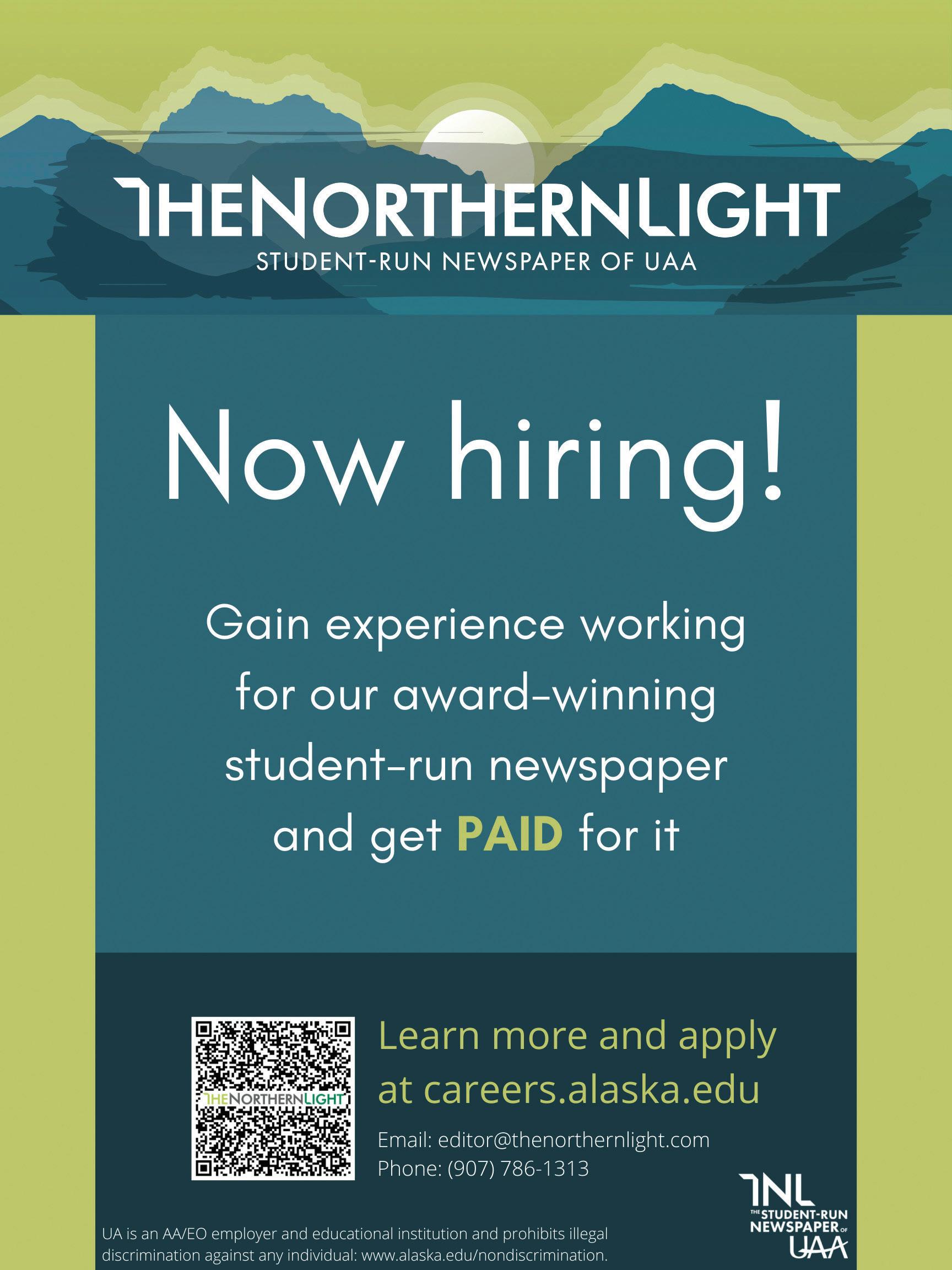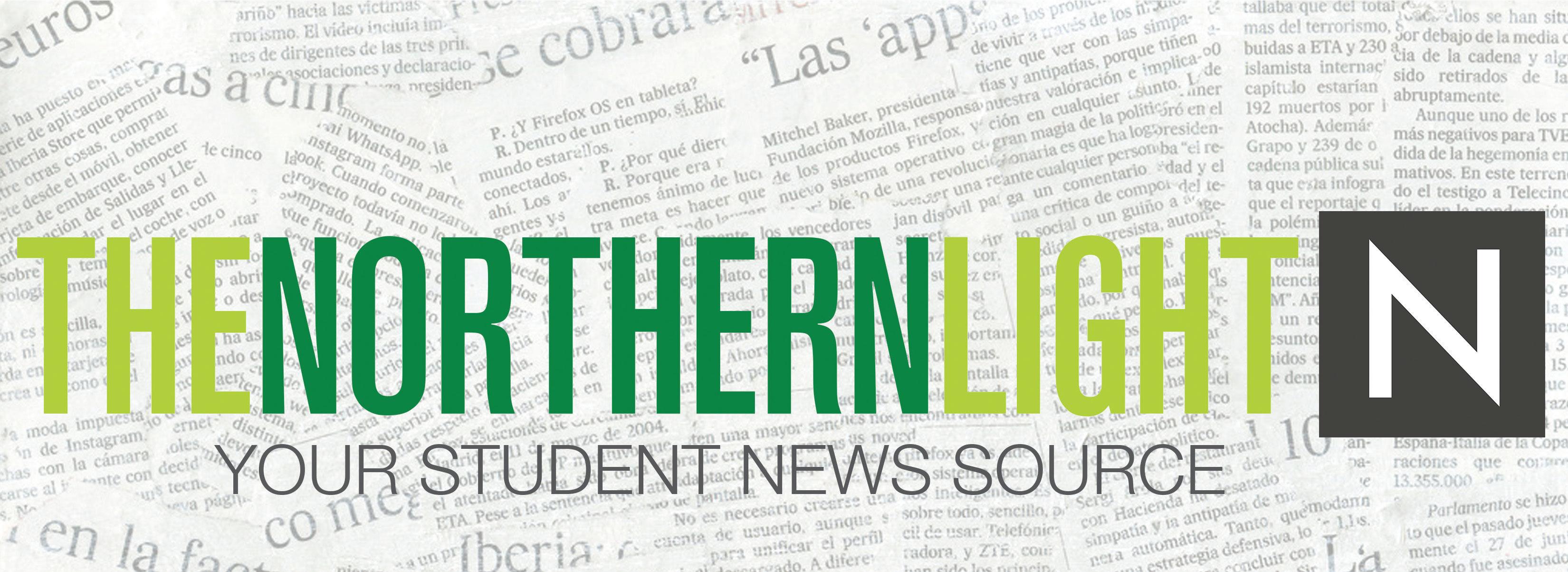SPORTS PAGE 6
Seawolves women’s basketball dominates UAF


SPORTS PAGE 6
Seawolves women’s basketball dominates UAF

Completing its first full year, the war in Ukraine has proven disastrous for Russia, strengthened western alliances and has given Ukraine a new place on the world stage.
By Kyle Ivacic news2@thenorthernlight.org
The ongoing war in Ukraine passed the oneyear mark on Feb. 20. Damage has been wrought across the country and destabilized the already strained relationship between Russia and many countries across the globe. The relative post-Cold
War peace in the West – termed “the end of history” by political scientist Francis Fukuyama – has been upended.
In February 2022, Russian President Vladimir Putin launched the assault against Ukraine – under the guise of “denazification” and “liberation” –hoping to swiftly capture its capital city, Kyiv, and annex the nation into the
Russian Federation. Putin also pointed to the shared histories of Russia and Ukraine as a catalyst for the invasion which he calls a “special military operation”.
For years, military leaders, politicians and international policy experts feared such Russian aggression in Eastern Europe and the world at large.
Seawolf Debate: ‘China dreams in terms that the U.S. does not understand’
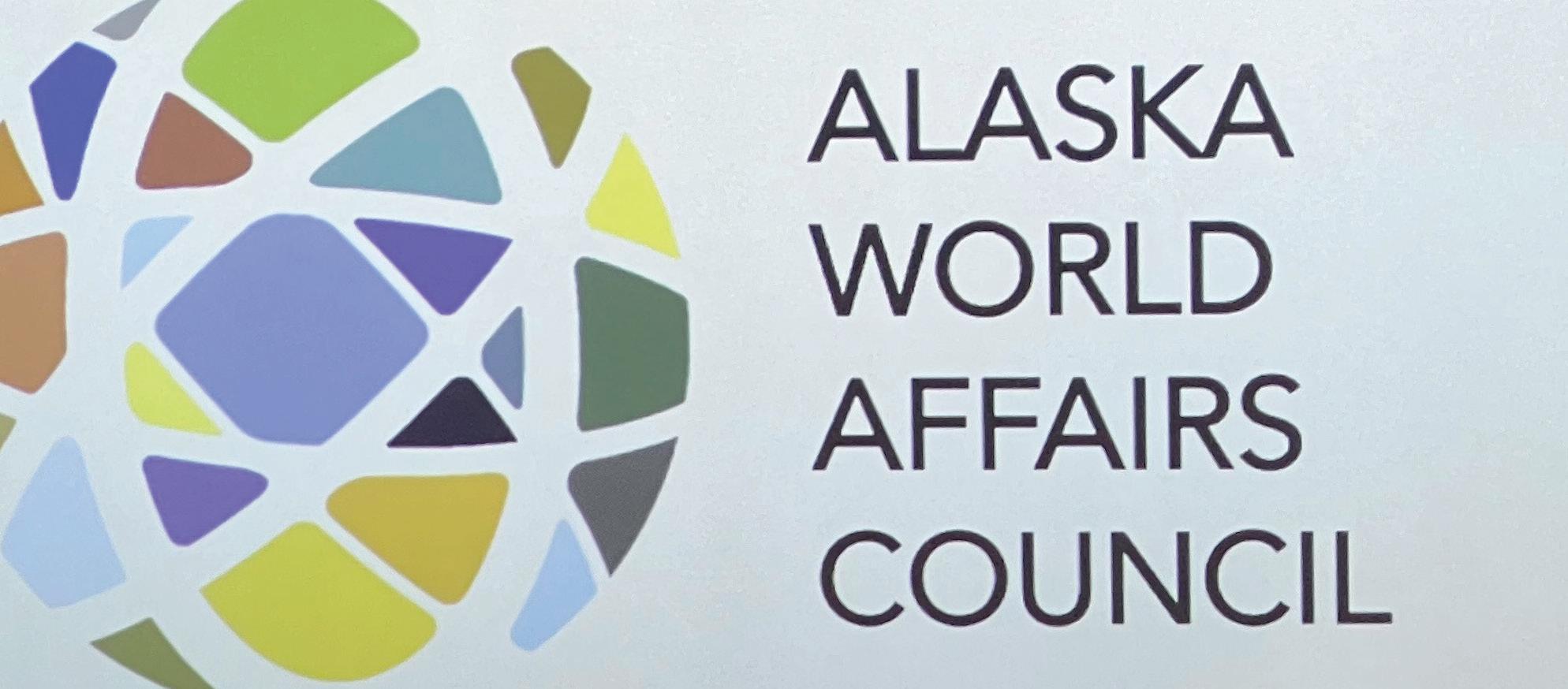
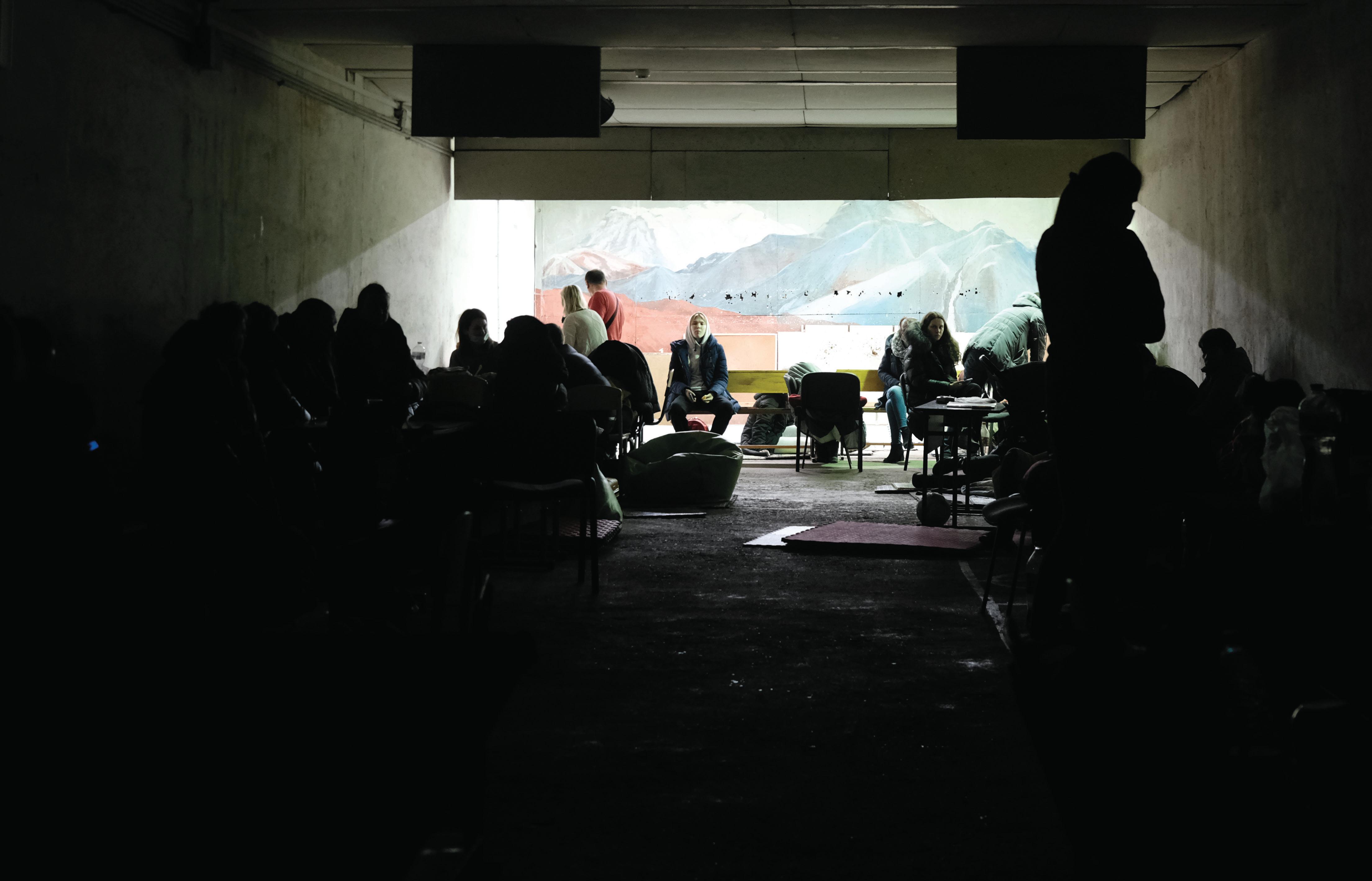
Some feared a lackluster response by the NATO Alliance while others were concerned that too much force by Western nations could result in the es-
‘Advising 2.0’ : Story behind UAA’s new advising system, how it works
TNL has spent the last month looking into academic advising at UAA. This is the final story in that series.
By Taylor Heckart, Matthew Schmitz and Kyle Ivacic
The shift in UAA’s advising system began in April 2022 when Chancellor Sean Parnell sent out a memorandum to the provost and vice chancellor of Student Affairs, Denise
Runge, charging her with creating a working group to create a “student-first” approach to academic advising.
In an interview with The Northern Light, Par-
nell said that there was inconsistency between the experience of students under first-year advising and students who transitioned to advisors in the various university colleges after their first year.
“There were gaps there,” he said, and “people were falling through the cracks … It clearly needed improvement.”
After becoming Chancellor, Parnell said that he
was hearing from different groups and individuals that there were issues.
“If I’m hearing it several times, it’s definitely something to pay attention to.”
Parnell’s memo recognized key challenges with academic advising.
Parnell wrote that First Year Advising’s centralized model did not “serve students in all academic colleges, campuses, or
calation of a conflict with Russia.
The world braced for a catastrophic Russian victory over Ukraine as the invasion began.
programs,” that the decentralized model of advising across colleges led to inconsistent advising experiences, that these practices often led to redundancies, and that caseloads varied between advisors.
In an email to The Northern Light, Provost and Vice Chancellor for Academic Affairs Denise Runge wrote that she worked with Parnell “to launch the committee that ultimately recommended the advising changes we are now implementing.”
According to her email there were a few issues that caused them to look
More than
for changes, including a larger than expected number of advising related problems and complaints from students and parents regarding long wait times for appointments.
She wrote that “survey data from UAA students … showed dissatisfaction with advising, including comments about how difficult it can be to ‘find’ the correct advisor for a particular program, not knowing how to access advising support, and dif-
A series of bed bug sightings in UAA’s Fine Arts Building have prompted action by UAA Environmental Health and Safety, Risk Management.
By Kyle Ivacic news2@thenorthernlight.org
Rumors of bed bugs present in the Fine Arts building have been circulating in recent weeks – cemented by four student-reported sightings that caused UAA Environmental Health and Safety, Risk Management to perform multiple sweeps of the building.
While an initial sweep of the building didn’t find any bed bugs, someone later found a live bed bug on their pants. This discovery prompted further action, including the placement of traps throughout the building, which resulted in the capture of three live
bed bugs on the second floor.
These three bed bugs led Risk Management to use a chemical spray on the second floor on Feb. 7 and quarantine the floor’s public furniture. No live bed bugs were found after that point.
An interview with Director of Risk Management Tim Edwards revealed that, at this time, students are at low risk of receiving bed bugs from the building’s furniture.
The belief by Edwards and others in Risk Management is that the bed bugs came in on the clothing of someone who is dealing with an infestation at home. Edwards said that the confirmed
bed bugs have all been mature, a sign that they are not growing within the Fine Arts building.
Edwards said that “we have [the situation] in pretty good shape” and that sightings are taken seriously and are being met with the appropriate response as determined by Eagle Pest, UAA’s contracted pest control provider.
UAA Risk Management will fully pay for the extermination expenses of any student who reports a home bed bug infestation, said Edwards.
“We’re just [...] going on your word,” Edwards said in regard to students who claim that their home has been infested as a re -
sult of being exposed to them at UAA.
When a student bed bug report comes in, Risk Management does a sweep of the building with a bedbug-sniffing dog and quarantines furniture that the dog deems suspicious. Over the coming weeks, Risk Management plans to regularly sweep the building until the dog no longer finds anything out of the ordinary.
To avoid having to use chemicals again, Edwards said that Risk Management has invested in a warming tent that can heat up furniture and personal items on site to the temperature at which bed bugs will die. In addition, students who do not want to hang their coats or other personal items on public hooks are being offered private bins to put these items in.
Bed bug traps are available, free of charge, to students or staff who spend time in the Fine Arts building and want to put traps in their home.
It is requested that students who think they have found a bed bug, trap it in a container and present it to Risk Management in order to determine what insect the student has found. Students who would like to file a claim or request bed bug traps can contact UAA Risk Management at uaa_ehsrms@ alaska.edu.
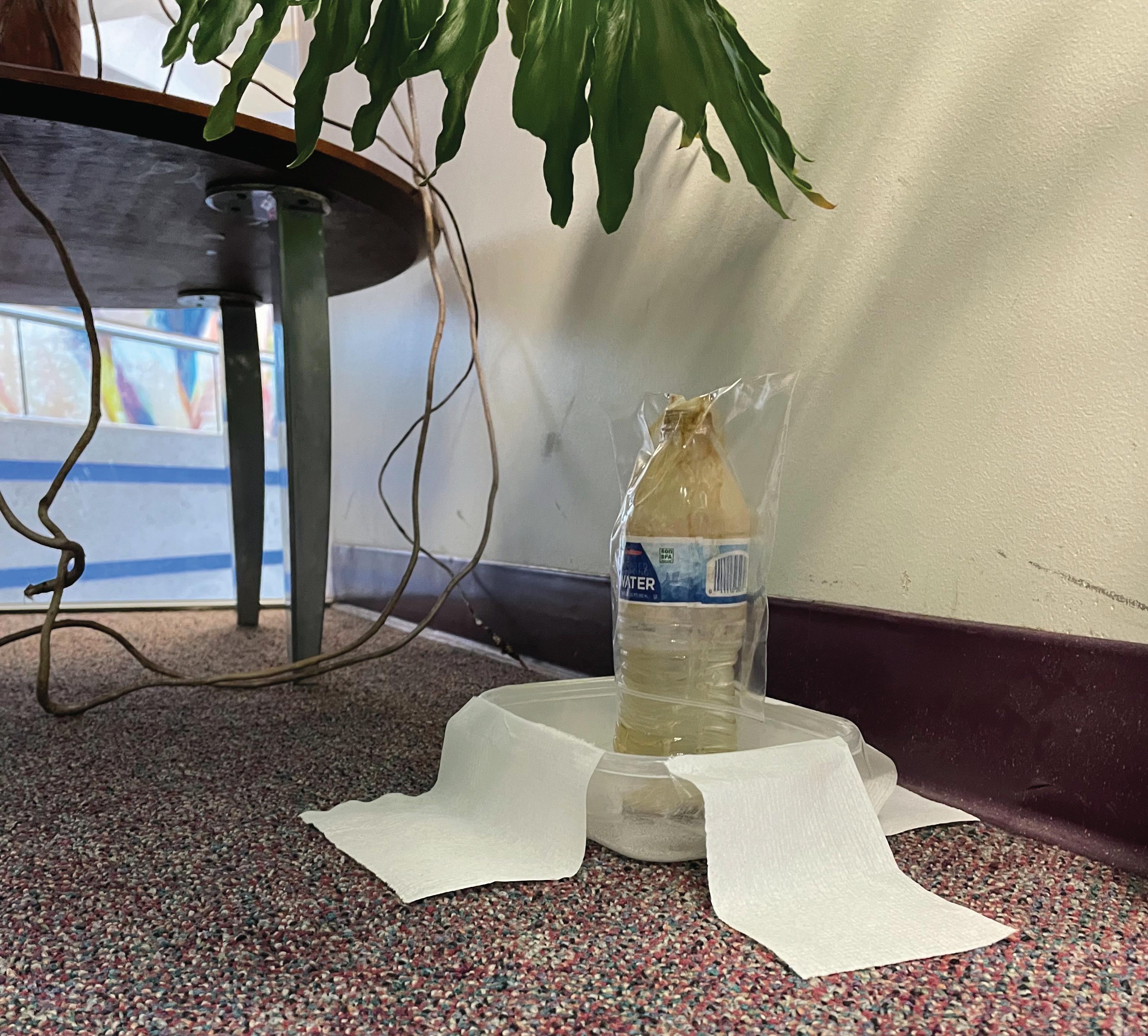
Russia’s capabilities, a weakened West and the general lack of stability in Eastern Europe seemed to point toward the same dire conclusion: Russia would defeat Ukraine.
Ukrainian war efforts, however, have hit Russia harder than expected and revealed a disheveled Russian military that is much less capable than once believed.
To discuss the first year of the war, UAA’s Institute of Social and Economic Research and the UAA College of Business and Public Policy co-hosted a webinar featuring Chad Briggs on Feb. 27.
Briggs was a professor at UAA from 2019 to 2022 and has years of experience studying and teaching in Eastern Europe and has performed contract work for the U.S. government in the region. He gave an overview of the war in which he highlighted Russian losses, the surprising successes of the Ukrainian military and the West’s unexpectedly strong response to the war.
According to Briggs’s presentation, as of Feb. 22, Russia has lost at least 145,060 troops, 3,334 battle tanks, 2,345 artillery systems and 299 warplanes among numerous other losses. In a Feb. 7 Forbes article, David Axe predicted, based on expert analysis, that total Russian troop casualties likely stand at 270,000.
Briggs said that the Russian invasion has faced many setbacks due to a strong Ukrainian resistance. Russia failed to capture Kyiv and Odesa and never seized air superiority over Ukrainian skies. Briggs said poor Russian troop organization and undermanned battalions were two of the main culprits in Russia’s failure.
In an email to The Northern Light, Briggs further explained Russia’s weaknesses:
“Russia lacks training and organization. Its military long relied on using overwhelming
firepower, but unlike Western militaries it never invested in making sure its troops could operate independently. … Ukraine has taken advantage of these [shortcomings].”
Briggs also described Russia’s lack of proper security measures:
“For example,” he wrote, “Russian generals would use cell phones for communications, allowing Ukraine to zero in on the command groups and [kill] a surprising number of flag officers.”
Ukraine has sustained losses of its own. The Office of the United Nations High Commissioner for Human Rights has recorded 8,101 civilian deaths and 13,479 civilian injuries in Ukraine as of Feb. 27.
According to the Stockholm International Peace Research Institute, the war had dealt between $2.2 billion and $6.4 billion in damages to the Ukrainian agricultural sector by June of 2022 – a concerning statistic because of Ukraine’s position as one of the world’s leading grain exporters.
Ukraine’s infrastructure has been severely weakened by Russian attacks – with Russia having placed special emphasis on damaging Ukrainian power supplies through attacks on power plants and substations. Rolling blackouts have become common across Ukraine as electricity production and transmission capabilities dwindle.
The unified stance of NATO nations against Russia’s assault has been another of the war’s surprises. In an era marked by social upheaval in many western countries – especially within the United States – the NATO response against Russia came as a startling development in favor of Ukraine.
The United States alone has pledged roughly $75.1 billion in aid to Ukraine.
President Biden in Poland on Feb. 21 gave a speech in which
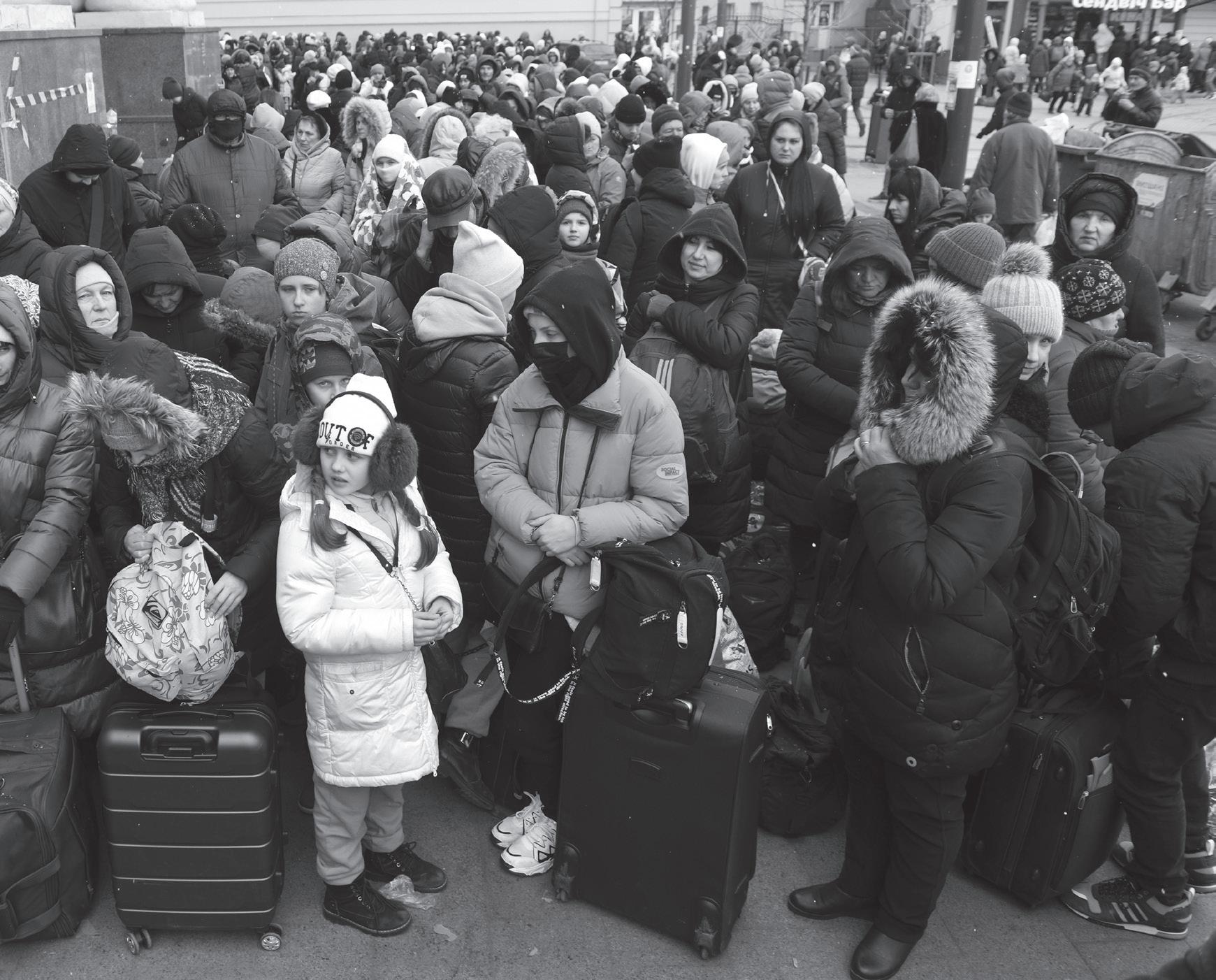
he said that Putin “thought he’d get the [Finlandization] of NATO. Instead, he got the NATOization of Finland – and Sweden. He thought NATO would fracture and divide. Instead, NATO is more united and more unified than ever.”
Much of Ukraine’s success in the war can be attributed to the country’s president Volodymyr Zelenskyy.
Zelenskyy grew to fame in Ukraine as the star of the hit Ukrainian television show Servant of the People in which he portrayed a history teacher turned president. The role propelled Zelenskyy into the political limelight for its anti-corruption stance. A remarkable chain of events led to the creation of a new Ukrainian political party also called Servant of the People with Zelenskyy as its presidential nominee. In April of 2019, Zelenskyy won the presidential contest with more than 70 percent of the vote.
Under Zelenskyy’s leadership, Ukraine has thus far been
able to galvanize Western support and fend off Russian occupation. The Ukrainian president has refused to go into hiding and has actively worked with countries around the world to receive much-needed aid.
According to Aljazeera, Breakaway factions in Ukraine’s Donetsk and Luhansk regions have threatened the internal peace of the country for years but have not yet proven burdensome enough to weaken the global community’s support for Ukraine. In fact, the recognition of these two regions by Russia as independent republics further stimulated anti-Russian sentiment in the West.
According to Reuters, the September 2022 Russianbacked annexation referendums in Russian-controlled regions of Ukraine are “seen as paving the way for Russian escalation of the war”.
Fears that the conflict will spill beyond Ukraine’s borders prompted Finland and Sweden to opt out of their historical poli-
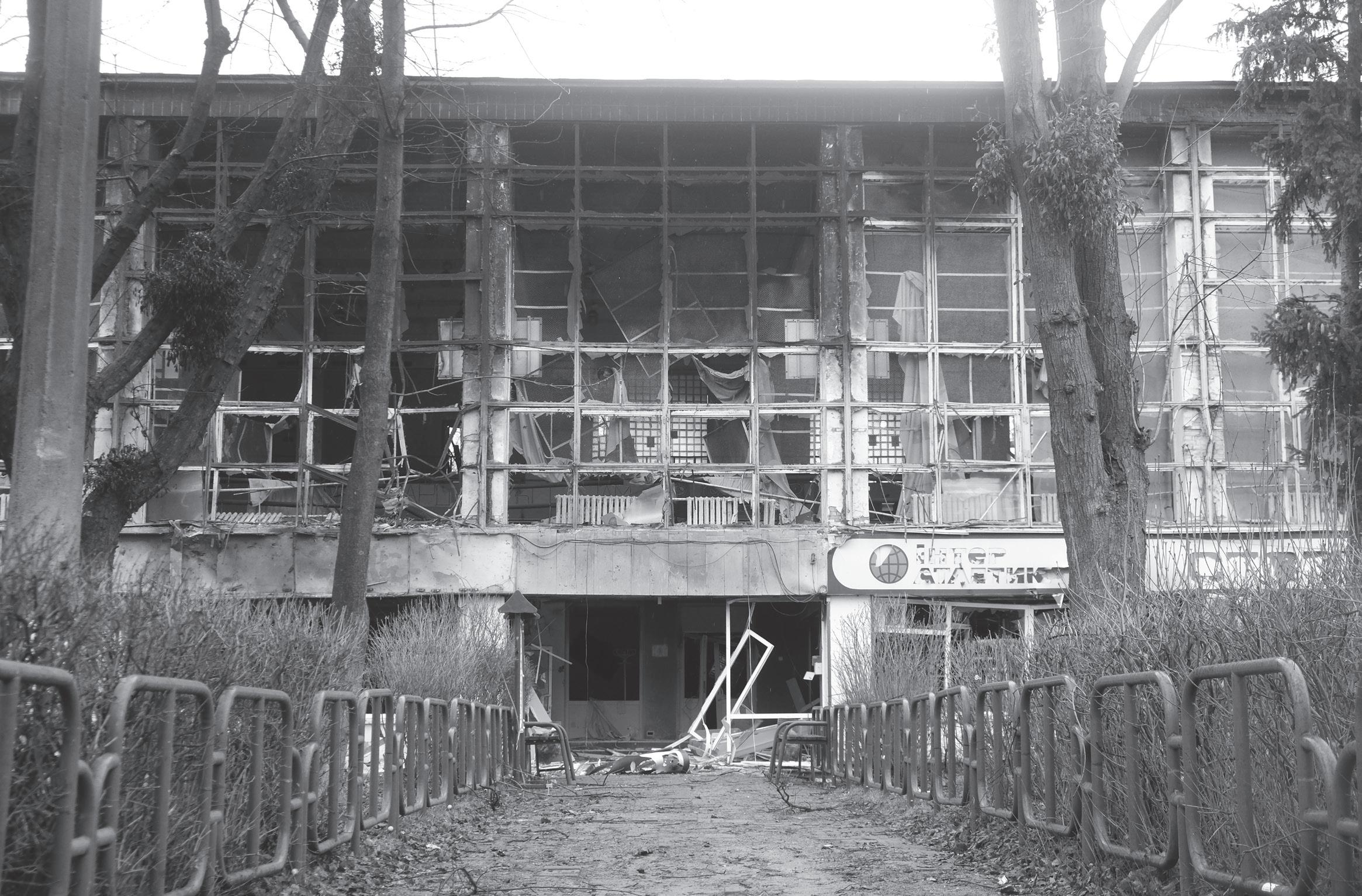
cies of neutrality and apply for admission to NATO.
Ukraine has itself begun the process of further allying with the West. According to Reuters Ukraine applied for fast-track admission to NATO last September and has been granted European Union candidate status. While Ukraine cannot join either organization until it meets a multitude of requirements – the moves toward further allyship have cemented both Ukraine’s and the West’s commitment to an agenda that opposes Russian authoritarianism.
While Western support for Ukraine remains strong, some question how long support will hold out. In his presentation, Dr. Briggs said that a war of attrition – a war in which one or both sides attempt to wear down the other to the point of collapse –would be in Russia’s favor.
Although Russia has performed poorly, it has the power to hold out longer than Ukraine because of its larger population and greater access to resources. The aid sent to Ukraine from around the world has been largely responsible for keeping the country afloat. Zelenskyy and other Ukrainian leaders must continue to prove competent and trustworthy to maintain the flow of money and resources coming into the country.
Some 8 million refugees –the vast majority being women and children – have flooded out of Ukraine in search of safety from Russia’s violence – hundreds of which have found sanctuary in Alaska according to Alaska Public Media. Alaskans are working with programs such as Uniting for Ukraine to provide refugees with resources and support.
How much longer the war goes on is anyone’s guess. Sooner or later, the billions of dollars in aid, strong Western rhetoric and the resourcefulness of Ukrainian troops and leadership will prove effective or not against Russia, and this war will come to an end.
By Kyle Ivacic news2@thenorthernlight.org
February began with a bang thanks to the efforts of Student Life & Leadership in coordinating with student organizations to host the Student Involvement Fair. On Wednesday, Feb. 1, the Student Union was host to booths promoting extracurriculars, work opportunities and campus involvement groups.
Student organization coordinator Shelby Kriegh reached out by email to discuss the event and the planning behind it. In her email, Kriegh wrote that making the arrangements with organizations was “quite simple” due to the fact that everything was streamlined using a Google Form. She and her team provided every registered organization with a table and chairs that were “up to each individual group to staff and decorate.” Kriegh’s goal for the event was to provide a space where students could learn about ways to get involved.
The event was marked by a friendly atmosphere and smiling faces. Some club members passed out pamphlets, baked goods, candy, and chocolates in attempts to gain the interest of passersby. Oth-
ers beckoned students in using bright posters or games.
The Anthropology Club displayed model human skulls of various ages – the goal being for students to guess the relative age of each skull compared to the others. Another set of skulls were modeled off of Neanderthals, and students were asked to guess which skull was male and which was female. The club is planning hikes and other outdoor activities for later in the semester.
The German Culture Club showed off German-themed keepsakes and pins with pictures of various German cities on them. They meet every Friday at the Black Cup to hold conversations in German in order to give students learning the language a chance to practice.
Pamphlets from UAA’s Filipino Culture Club, known as Kabayan Community, show pictures of past club events such as a karaoke night and a halo halo mixer. On hand were sweets from East Asia –the most memorable of which was a packet of mango-flavored pop rocklike candy that had an intense crackle.
Also in attendance
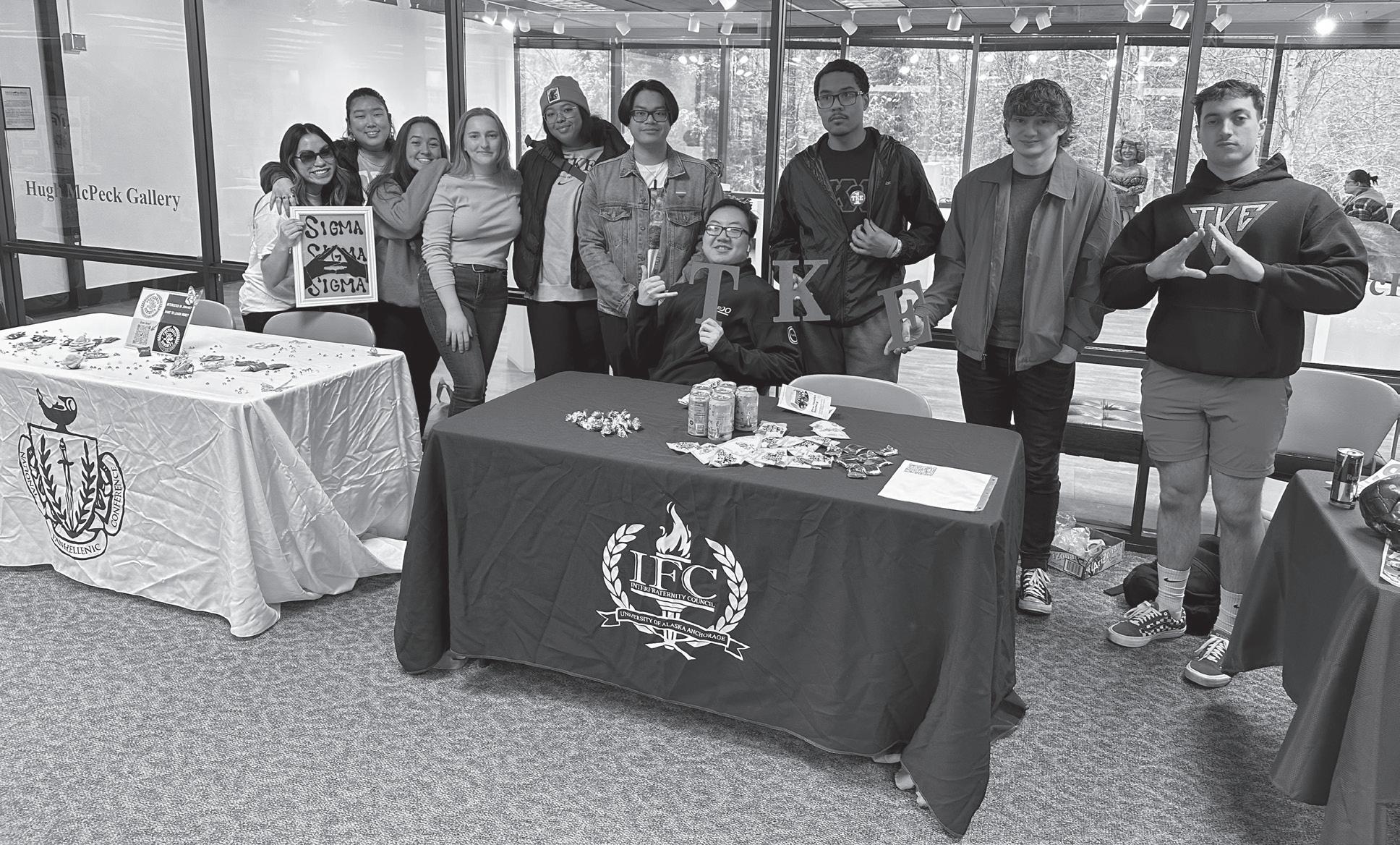
were the Army ROTC, a climate change awareness organization, the TKE fraternity, the UAA Robotics Team and an improv club, among others.
Overall, the Student Involvement Fair delivered on providing students with connections, opportunities and ideas for how to spend their time on campus. To find more information about UAA clubs and organizations, you can visit the student organizations page on the university website.
This story is part of a series by The Northern Light looking into advising at UAA and focuses on USUAA’s role in advising decisions and follows up on changes coming to the advising department.
By Kyle Ivacic news2@thenorthernlight.org
As part of The Northern Light’s look into advising, we felt it would be important to hear from UAA’s Union of Students, also known as USUAA, because the organization has sway over university policy. I reached out to Shanone Tejada, USUAA’s vice president for more details.
While USUAA does not have any direct legislative power to deal with the university’s advising system, Tejada said that the organization is able to “raise a voice” to issues experienced by the student population by putting out resolutions encouraging reform. Furthermore,
Tejada said, “most of the work we do is advocacy in meetings by talking to […] people who make these decisions.”
In an email, USUAA President Katie Scoggin, gave an example of such advocacy: “we hope to […] facilitate focus groups to analyze and gather feedback about the new strategies being applied. Kind of like an ongoing evaluation to ensure continuous improvement of the department.”
In his interview, Tejada said that USUAA is “kept in the loop” in regard to advising issues due to the organization’s “good relationship” with Vice Provost for Student Success Melanie Hulbert and advising director Valerie Robideaux who spoke at
USUAA meetings in December and February.
Tejada shared details on what the Office of Student Success is calling “Advising 2.0” – a complete overhaul of the current system, which is expected to be fully rolled out by the fall semester. This new system will put all advisors under the control of the Office of Student Success, rather than the current, decentralized system, in which first year advisors operate as their own entity under each college, and colleges are separately responsible for the advising curriculum beyond the first year.
Tejada pointed out that one issue with the previous advising system is that one advisor can be responsible for more than 500 students. “That’s the
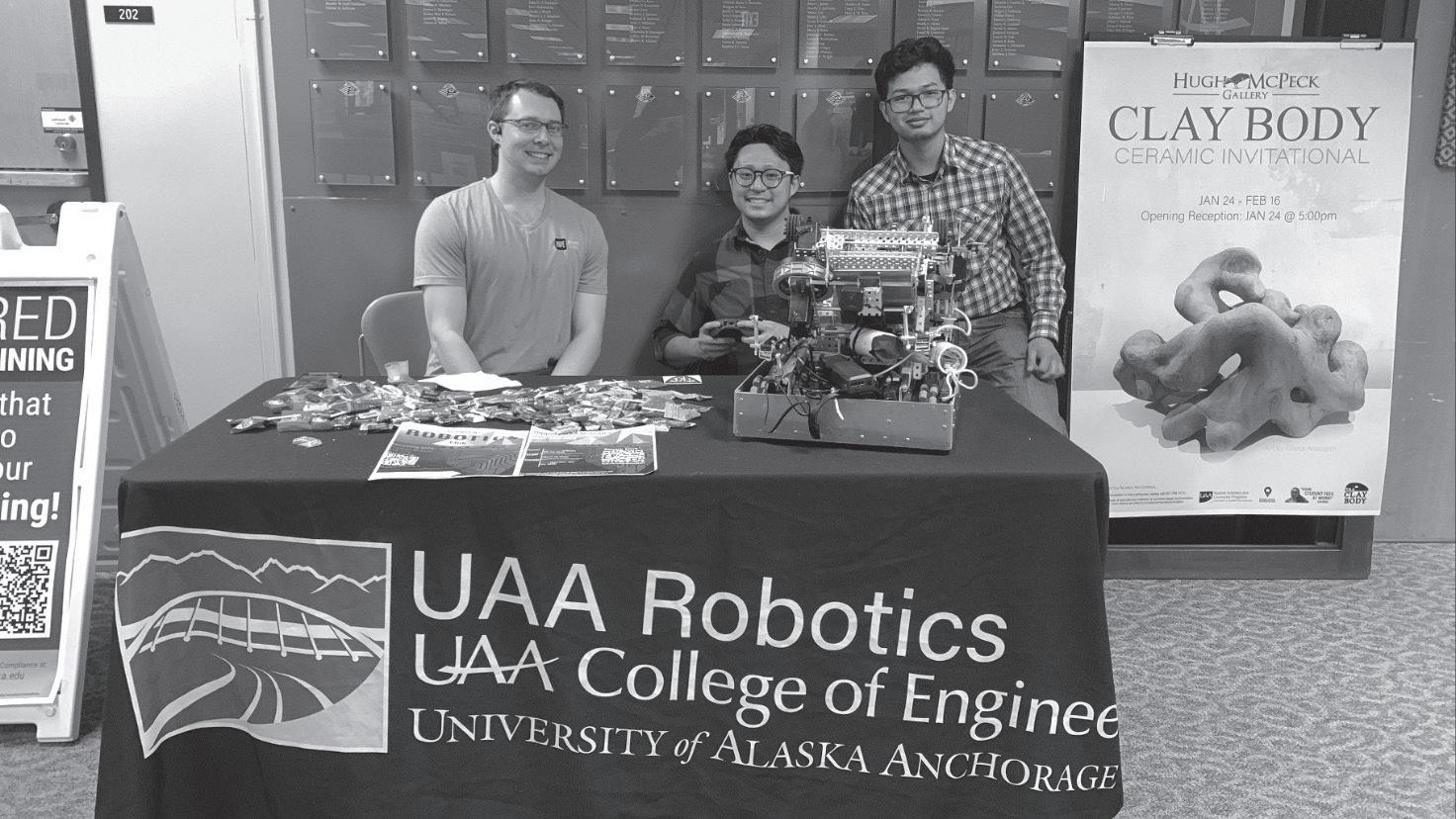
problem with miscommunication. They’re really booked up,” he said.
“The way we’re tackling that is by having some organizational structure. So that colleges are not competing against each other, but they’re working under one department, in a way consolidated, but also still within their respective colleges, so that they can tailor the needs of their students.”
According to Tejada, the university is also working to hire more advisors to alleviate the pressure and workload that stands on current advisors.
In a letter from Melanie Hulbert emailed to university staff on Feb. 3, she wrote that over the course of the spring semester the university will “develop, implement, and assess a common student outreach plan for Fall 23 advising and registration.” It is also noted that first-year engagement and appointment scheduling practices will be updated “to provide friendly and helpful support.”
Time will tell if Advising 2.0 changes will accomplish the stated goal in Hulbert’s letter, which is “to improve the student experience while also
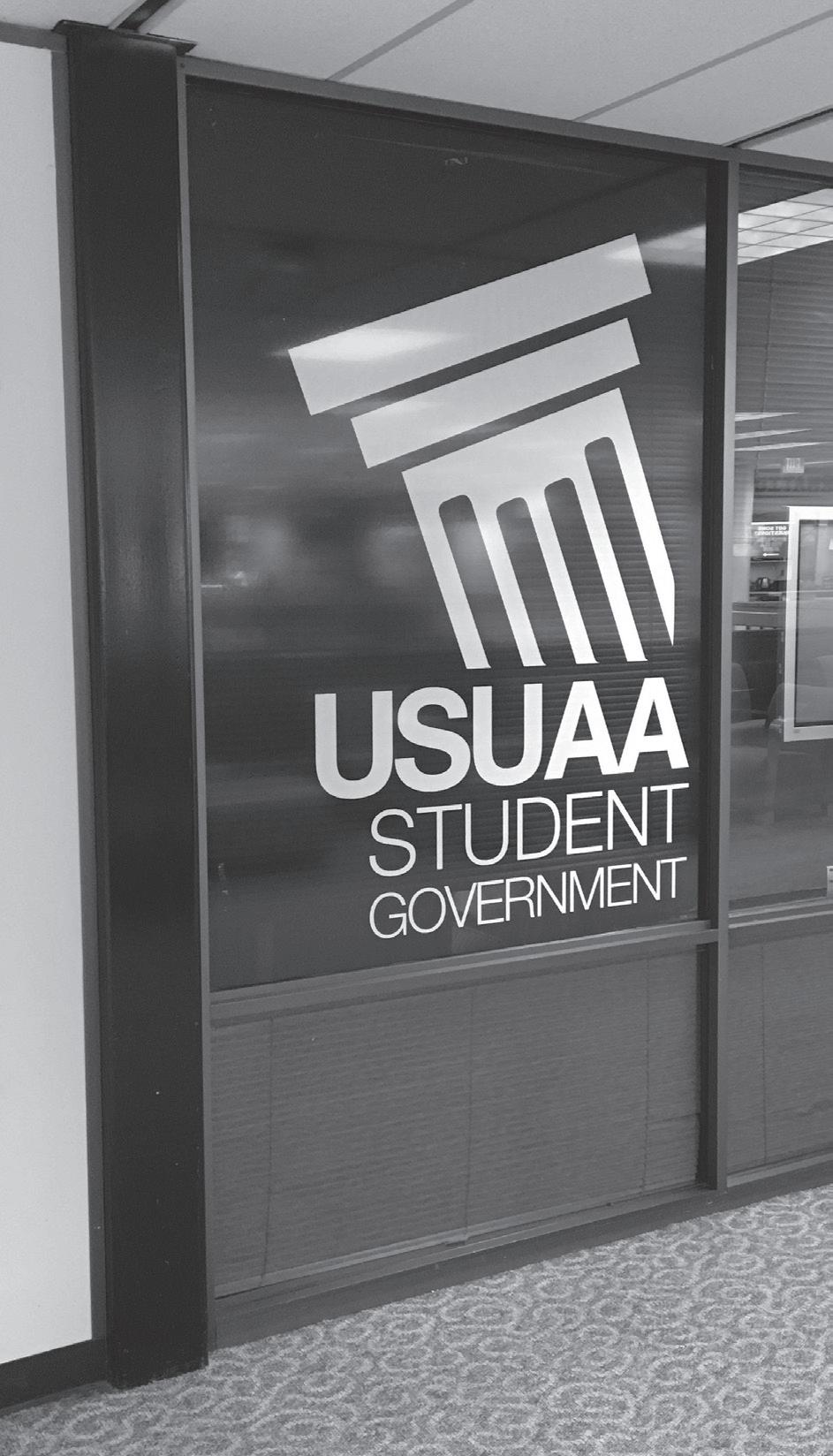
providing stability to students, faculty, staff, and administrators who rely on the important work of our advisors.”
The Northern Light is doing a series looking into advising at UAA. This story follows professors and their opinions, but professors made it clear that they were speaking on behalf of their own personal experiences, and not on behalf of all faculty at UAA.
By Taylor Heckart new3@thenorthernlight.org
As UAA’s new centralized advising system, temporarily known as “Advising 2.0,” gets underway this semester, the Northern Light has reached out to professors to receive their input on advising.
In an email, Ian Hartman, the president of UAA’s Faculty Senate and an associate professor of history, wrote, “While there does not seem to be a faculty consensus around the pros and cons of the advising reorganization, we have expressed a few concerns to the provost.”
“We’ve had incredibly hard working advisors, but they’ve not always been supported at CAS,” said Hartman in an interview.
Hartman said that with such a demanding job, turnover with advisors could be high. This was challenging due to the level of training and effort required
to get an advisor to be able to do effective advising.
When it comes to faculty involvement in the advising restructuring process, Hartman said there have been conversations with provost Denise Runge’s office. And though faculty haven’t been left entirely in the dark, they still have questions about the specifics.
“To the provost’s credit,” said Hartman, “when we’ve asked for meetings, she has shown up and has tried to explain it to us. We have had questions. Our meetings have resulted in more questions. We’ve had to go back to the provost to get more clarification.”
Hartman said that looking forward, some questions about the new system will focus on how UAA will evaluate and troubleshoot problems.
Hartman also said that the Faculty Senate advisory board have urged that if there is any any additional funding going to this new advising effort it should “be
directed to those who interface with students on a daily basis rather than middleand higher-level administration.”
Professor Sarah Kirk, in the department of Writing, has had decades of experience with the UAA advising process. She was a faculty advisor in the 90s to help provide a “holistic” approach to advising before academic advising was implemented. Since then, the process of advising has changed at UAA, but she has still maintained interest and a level of involvement with advising.
Kirk was on the initial hiring team for First Year advising when the program began. First Year Advising will now no longer exist under the new Advising 2.0 system. First Year advisors have instead become a part of three different cohorts that serve different colleges at UAA.
From a professor’s perspective, First Year advising was an important tool when it came to supporting new students and finding people they could turn to for help, said Kirk. “It was awesome to me as a faculty member who reaches out a lot, especially at the beginning of the year, to advisors about students.”
Kirk said that one of the strengths of the First Year advising program was the support that First Year advisors were able to provide for students who may need it, and it was easy for her to reach out to the
first year advising team and make sure there was someone a student could talk to.
“There was never anyone who said ‘that isn’t my person,’” said Kirk, instead, first year advising would direct people where they needed to be. Kirk said that there was a value to having those advisors in one “shared physical unit, to really help each other out and learn from each other.”
Kirk has concerns that because of the first year advising system being broken apart, both as a group and to different physical offices, “they don’t have that camaraderie of shared understanding.”
Looking forward, these faculty members have expressed the desire to make sure that students can get quality advising that they need, and will continue to look at this new system as it develops.
Ian Hartman wrote that “Advising has not been uniformly strong across the colleges, but I would also hope and expect that the administration takes the necessary measures to strengthen and build off of what is working and place the greater focus on fixing what is not.”
Some answers to these concerns can be found in the front page article on academic advising, “‘Advisign 2.0’ : Story behind UAA’s new advising system, how it works”.
The Northern Light is doing a series looking into advising at UAA. This story focuses on advisors’ tips for getting the most out of UAA’s advising system.
By Kyle Ivacic news2@thenorthernlight.org
To gauge the advising system at UAA through the eyes of the advisors themselves, TNL conducted interviews with four advisors from different UAA colleges. These interviews brought light to important aspects of advising and gave new insights on how students can utilize their advisors.
College of Health advisor Jennifer Spencer said that the most important way for a student to prepare for an advising appointment is by “looking over … the website of the program that they’re interested in” and having questions prepared – both general questions or those of more
immediate concern.
“Don’t be afraid to ask us questions,” said Spencer.
To prepare for an advising appointment, Whitney Flores, who advises for the Community and Technical College as well as the Culinary Arts and Hospitality Administration program, said that “it really depends on what the student is needing advising for.” She pointed to tools such as DegreeWorks and Navigate that can help students come up with ideas and questions before an advising appointment.
In certain cases, students need to have documentation ready – especially in a high-stakes time like an academic appeal. To get the most out of advising, Flores recommends that students “do regular check-ins, have a good working rela-
tionship with [their advisor]” and be responsive when their advisor reaches out. Flores warned against self-advising or relying on friends for advising. Academic advisors are “program experts” who “understand the ins and outs and nuances of those particular programs” in a way that a friend or family member likely doesn’t. College of Arts and Sciences advisor Leslie Olberding said she knows “that sometimes students have a hard time opening up, especially if they haven’t met [their advisor].”
She said to keep in mind that advisors are a “safe space” and that there is “no judgment.”
Olberding said that students should give advisors an explanation of what they need beforehand – either by email or by the information box that is available when making an appointment online.
Christine Hunt, also of the College of Arts and Sciences, said that having an objective for speaking with an advisor is important. Whether that objective is education or career related, Hunt said it is always good to touch base with your
advisor.
“Going through college is scary and exciting… so, it’s just our job to help you guys figure out what the best route is for you and – no matter what anybody says – it’s your life and [we’re] advocating for you guys as students.”
Regarding “Advising 2.0” – the new advising system coming into place in the fall semester – these advisors all said that it will hopefully advance student interests. They highlighted streamlined advising practices and new administrative channels through which to communicate. The new system will centralize advising under the Office of Student Success and even-out advisor workloads. No advisor voiced any specific issues with the advising system as it stands.
To find advisor information, students can visit the UAA advising webpage or log into the Navigate advising website or app with their student credentials.
The Northern Light will be following up with more stories on advising at UAA.
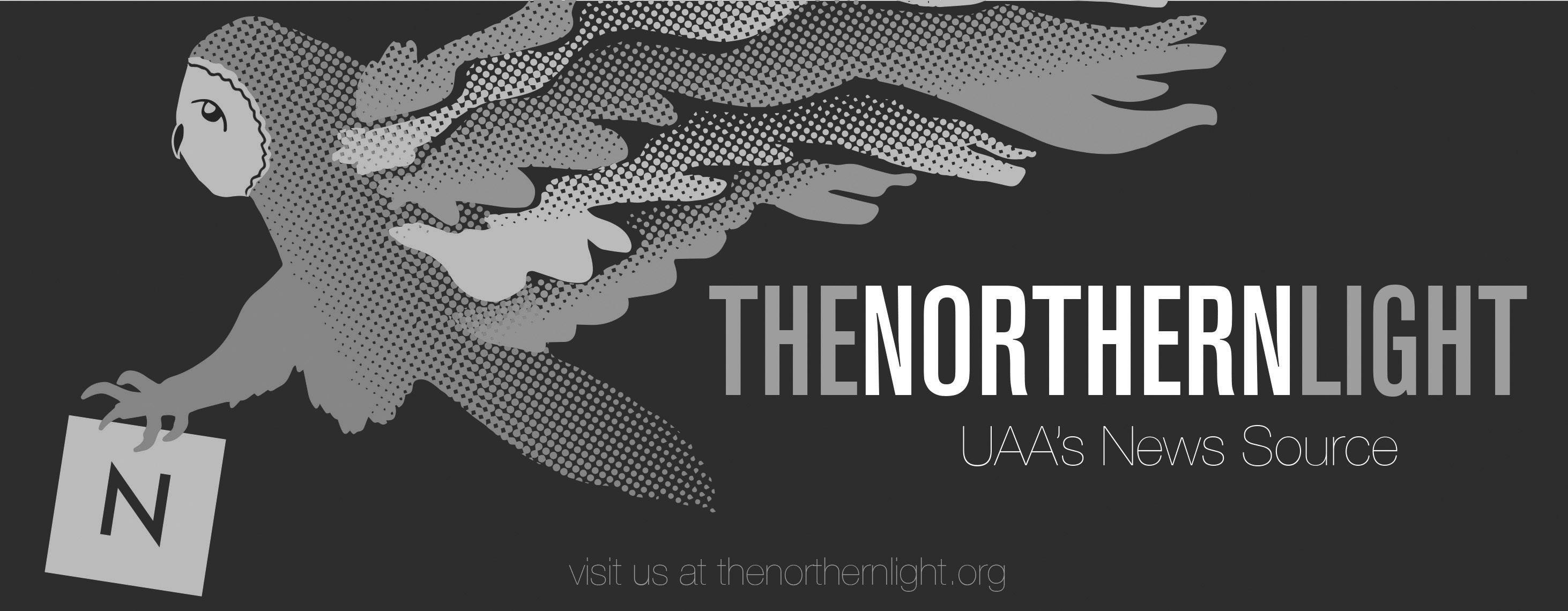
ficulties in getting appointments.”
In fall 2022 Valerie Robideaux became the interim executive director of Advising to take on changing advising at UAA. In an interview with The Northern Light, Robideaux said that the goal with this new advising system was to make both the student and advisor experience consistent.
“Some advisors had student caseloads – the population of students that they work with – in the 300s or 400s. Some had them in the 200s. Some had them in the one-thousands,” said Robideaux, “But they were all in the same position at the university, meaning they’re all being paid the same amount.”
Robideaux said that under the new structure, advisors will have similar caseloads, somewhere between 350 to 400 students.
Now, instead of reporting directly to deans, advisors will report to one of three academic advising directors who have a “dotted line of connection” to the dean of the college they represent. Though advisors no longer report directly to the deans, the deans will still be involved with advising and have a connection to those advising directors.
This new system is also trying to address the issue of advisor turnover at UAA.
Parnell said the issue of turnover is a “problem all throughout the university,” and that “we have trouble throughout our employee ranks attracting and retaining employees because our pay is typically lower.”
Under the previous system, some ad-
visors had career advancement opportunities while some did not. Robideaux said this new system will work to combat advisor turnover by creating a “career ladder system,” where advisors can move up to higher positions after becoming proficient in their position.
Under this centralized system, First Year advising no longer exists. First year advisors will become a part of one of three academic advising cohorts. One will serve the College of Health and another the College of Arts and Sciences. The last cohort covers the College of Business and Public Policy, the College of Engineering, and the Community and Technical College.
Students who do not yet know what degree they are seeking will still have access to an advisor, said Robideaux.
“Technically ... the exploratory major is under the College of Arts and Sciences programs.” There will still be an advisor who exists to help these students, she said.
Under this new system, the First Year advising program no longer exists. The First Year advising program was created in 2018, said Robideaux, but what UAA learned during that time with that advising program isn’t being thrown out.
“Now we’re kind of expanding that model into the rest of professional academic advising.” Said Robideaux, “First Year advising will kind of be the guiding principle on how we work with our first and second year students.”
As this new system continues, Robideaux said that there will be ongoing conversations about how to support explor-
atory students who may have a specific interest they wish to explore.
“For instance, a student who’s still exploratory but knows they’re interested in a health profession – how can the College of Health advising team accommodate that? Is there a go-to person within that unit that the exploratory advisor and the College of Arts and Sciences team can work together [with] on how to support exploratory students in really common ways?”
By centralizing the advising experience, said Robideaux, students should be able to have standard experiences across colleges, meaning that even if a student completely changes their degree or college, the process of finding and meeting with an advisor should stay the same.
Previously, some colleges used certain technology and practices while others did not during advising appointments. By standardizing the experience, advisors and students will be expected to use the same technology and methods, making measuring effectiveness easier than it was under the previous system, said Robideaux.
“We’re going to be able to track and be able to see, okay, do the students who have one or two academic appointments with an advisor [...] have a better retention rate? Do they have better credit conditions? Do they have better term GPA’s?”
“All the advisors are going to be incorporated with their appointment schedule in Navigate – that compliments the mobile app – so students will be able to go in and schedule appointments with advisors that way.”
Advisors will also be reaching out to students to schedule advising appointments as a part of advising campaigns
throughout the year. Students should be hearing from their advisors about the upcoming semester shortly.
Robideaux said that they are still developing practices that come with this new advising system. Under the new centralized model, Robideaux is still working to figure out how best to address first and second year college students who may have different advising needs from students with more credits and who may be more familiar with UAA.
The system will likely continue to keep changing, said Robideaux, but there will likely be a stronger baseline of what this new system looks like in the fall.
“The vision that we have right now for student advising is to be a student-first advising team continuously evaluating and improving practices.” Said Robideaux, “We’re always learning more about the best approaches to work with students because we want to keep our ear to what other schools are doing and to make sure we’re leaving room for campus feedback.”
Advisors will also be a part of working groups with other advisors outside of their unit. These working groups will look at advisor onboarding, advisor professional development, student communications, and campus feedback.
When it comes to evaluating campus feedback, Robideaux says that the campus feedback group will look at “putting some surveys and focus groups and recommendations for how we can continue to assess with different stakeholder groups on campus– so faculty, staff, students– on the experience of advising, and feedback on what we are considering to be our student first advising.”
Amid talks of war and a low in U.S. and Chinese relations, The Alaska World Affairs Council hosted a forum discussing the impact of Chinese economic and military policies on the United States.
By Kyle Ivacic news2@thenorthernlight.org
Anchorage students were treated to a forum and debate – coordinated by the Alaska World Affairs Council – discussing the possibility of democratic governance emerging in China and the impact of Chinese policies on other countries, specifically the United States. Hosted at Bear Tooth Theater on Feb. 9, the event put particular focus on the challenges presented by tension within the U.S.-China relationship and included a debate performed by the UAA debate team.
Preceding the debate, the director of the Center of Excellence for Global Trade and Supply Chain Management, Sam Kaplan, spoke to the audience about the challenges, especially the economic challenges, that China presents to the United States. Kaplan theorizes that the United States and China are in a “competition of competence” – a push and shove game of trying to outperform each other economically.
His presentation drove home the idea that China poses a great threat to the U.S. both economically and militarily if the relationship between the two nations continues to destabilize.
What is causing this instability? Kaplan said that the clashing of ideologies by the two largest economies in the world is to blame. The Chinese government’s authoritarian tendencies and the U.S.’s liberal tendencies have created a battle for domi-
nance on the world stage.
These issues raise the question: Will China ever change?
To discuss this, members of Seawolf Debate appeared on stage to deliver exciting speeches. The pro side argued that political liberalization will never happen in China, while the con side argued that it can happen.
The pro side suggested that Chinese political liberalization will not happen because of Chinese economic ambitions being greater than political ambitions. Chinese culture is also often in support of measures that promote society over individuals. Additionally, they pointed to the fact that the current long-term plans of the Chinese Communist Party include more authoritarianism. A case in point being the extension of Xi Jinping’s presidency after Chinese lawmakers voted to abolish presidential term limits – a move that allows Xi to remain in power for life.
On the con side, debaters argued that if the U.S. can successfully act as a role model, China might sway toward liberalization. Another point made was that China’s aging and declining population has the potential to push the current Chinese government system toward irrelevance as younger generations seek more self-agency. According to debater Steve Cherry, “China dreams in terms that the U.S. does not understand,” suggesting that the precedent of thousands of years of Chinese culture provides the Chinese people with more patience in the process of actualizing liberal practices. They also claimed
that China’s slowing economic growth will shift ideologies from the economy to liberty.
At the debate’s conclusion, a panel of three judges determined that the con side won because of their presentation of less limiting arguments. One judge, Greg Wolf, who serves as the executive director of World Trade Center Alaska, also reminded the audience that Taiwan exemplifies Chinese culture and operates under a thriving democratic system. This reminder was meant to show that the Chinese people and their ways of think-
ing are compatible with political liberalization. The judges felt that Chinese political liberalization is possible under certain conditions.
Whether China liberalizes or not, the feud between the U.S. and China has dangerous potential and is one of the top concerns of U.S. foreign policy. The recent downing by the United States Air Force of a Chinese spy balloon that traversed U.S. skies was the starkest display of this conflict to date as military action escalates the conflict into a more tangible realm beyond economics.
The risk of war is high according to an internal U.S.Air Force memo sent out on Feb. 1
by the head of the Air Mobility Command, General Mike Minihan.
“My gut tells me we will fight in 2025. […] Xi’s team, reason, and opportunity are all aligned for 2025,” Minihan wrote.
Jake Werner and William Hartung wrote in a recent article published by The Nation that a policy of “constructive coexistence” is needed between the two countries to avoid a war that several organizations predict “would inflict heavy losses on both sides, destabilize the global economy, and run the risk of a nuclear confrontation, all while devastating rather than protecting Taiwan.”
Clearly, there is a need for constructive, thoughtful conversation and action. Peaceful solutions to our issues with China are much needed and public forums such as the one on Feb. 1 are an important space in which solutions can emerge and grow.
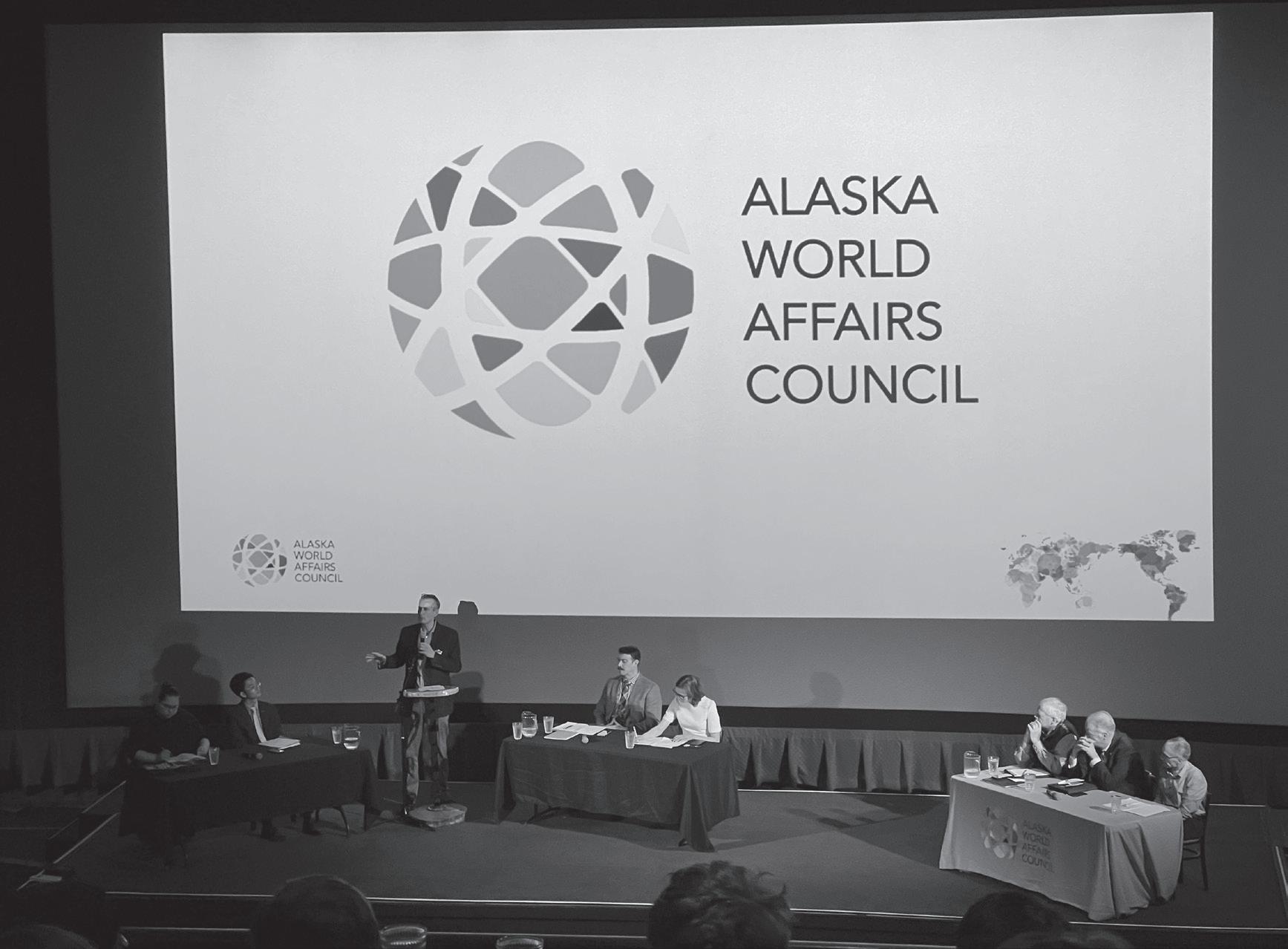
By Avery Williamson sports@thenorthernlight.org
The Seawolves’ sharp-shooting against the University of Alaska Fairbanks Nanooks on Feb. 4 at the Alaska Airlines Center allowed them to secure a huge 69-39 victory over their instate rivals.
The Nanooks pushed the pace right from the tip off. Only seven seconds in, they were driving to the hoop, but Kate Robertson was there to block the shot.
After Nicole Pinckney stopped the ball and dribbled it down the court, Vishe’ Rabb put the Seawolves on the scoreboard with a jumper.
Tubby Tovia helped advance UAA’s lead by drilling four foul shots. Tovia’s sharp shooting rubbed off on Jazzpher Evans, who drilled back-to-back jumpers.
With a little over a minute left in the first period, Rabb was fouled. After sinking both her free throws, she drilled a threepointer. The Seawolves led 18-7 at the end of the first quarter.
Steals by Anaiah Moore and Tovia early into the second pe-
riod set Jahnna Hajdukovich up for a three-pointer and extended UAA’s lead. Less than a minute later, Hajdukovich drilled another one, and 30 seconds after her second three-pointer, she scored in the paint.
The Nanooks tried to gain momentum after a layup from Emma McKenney, but Hajdukovich’s hot streak continued and she drilled yet another three-pointer, her 11th point in less than three minutes.
After being fouled on a fast break, Evans made two free throws to extend UAA’s lead to 31-9. The Seawolves held UAF to only five points in the second quarter and entered halftime with a 22 point advantage over
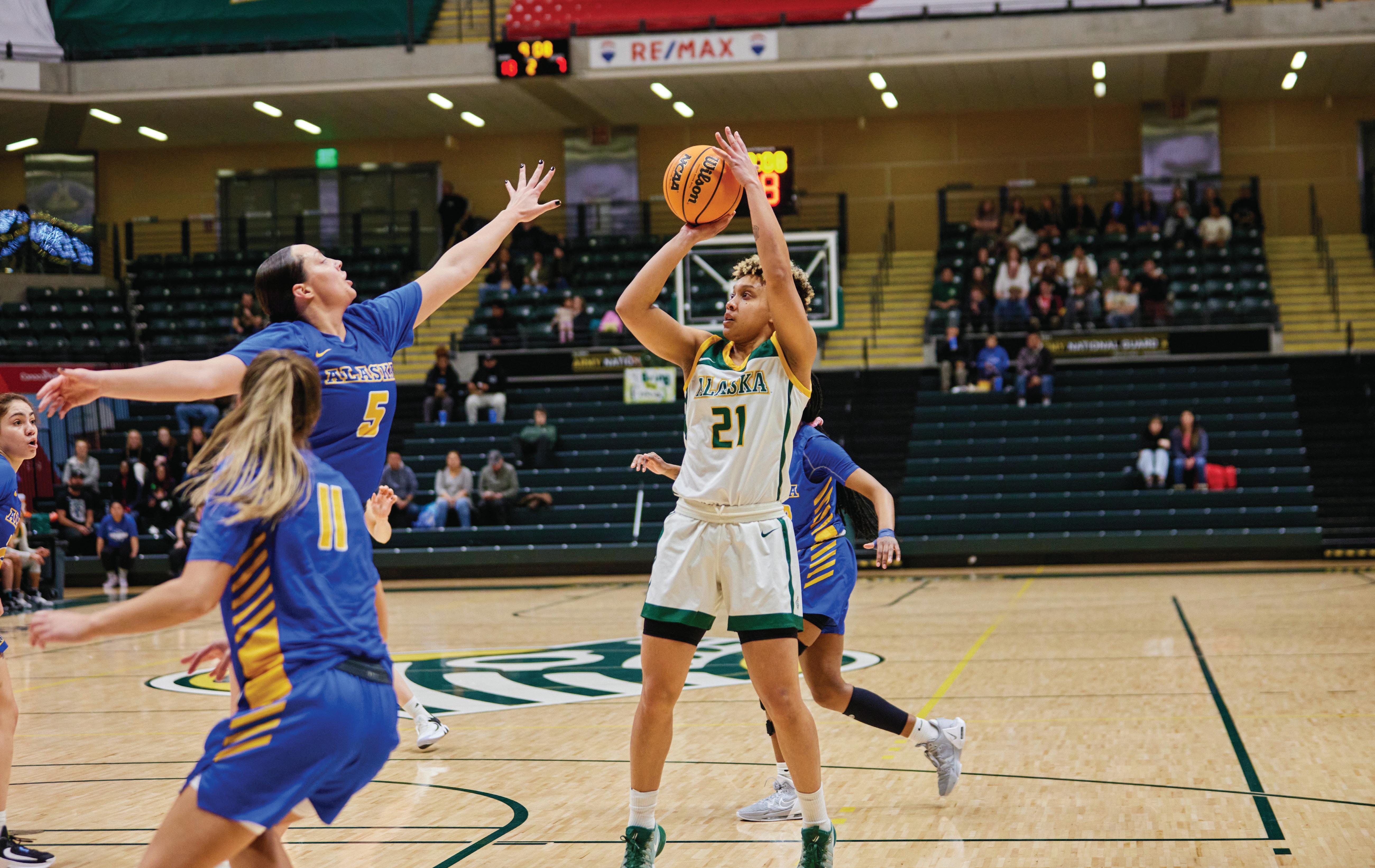
the in-state rivals.
Despite leading 34-12, the Seawolves maintained their momentum and played another strong quarter. However, several Seawolf fouls allowed the Nanooks to raise their score.
A few fouls wasn’t enough to put a damper on UAA’s sharpshooting, though. The Seawolves entered the final quarter with a 50-23 lead.
The Nanooks found their shooting rhythm in the fourth quarter, scoring 16 points in the final period. But the Seawolves didn’t let this faze them. They continued to drill their shots and handed UAF a 69-39 loss.
Hajdukovich led the Seawolves with 14 points and 6 rebounds, followed by Evans with 10 points and 5 rebounds. The team shot an impressive 42.3% from the three-point line.
Head to the Alaska Airlines Center on Feb. 16 at 7:30 p.m. to watch the Seawolves take on Saint Martin’s University. And for even more Seawolf action, head back on Feb. 18 at 6:30 p.m. to watch the game against Western Oregon University. Visit GoSeawolves.com for live links and stats.
By Avery Williamson sports@thenorthernlight.org
The Seawolves recorded an impressive 80-58 victory over the Western Oregon University Wolves in front of a home
crowd on Feb. 18. Vishe’ Rabb led UAA with 29 points. The game was hot from the tip off, with Jahnna Hajdukovich drilling a three pointer only 22 seconds into the game. Oregon responded though, with back-toback layups.
The Seawolves took an eightpoint lead after a layup by Kate Robertson with just over four minutes left in the first quarter. The Seawolves dominated the game from that point forward. UAA outscored WOU 14-3 for the rest of the first quarter.
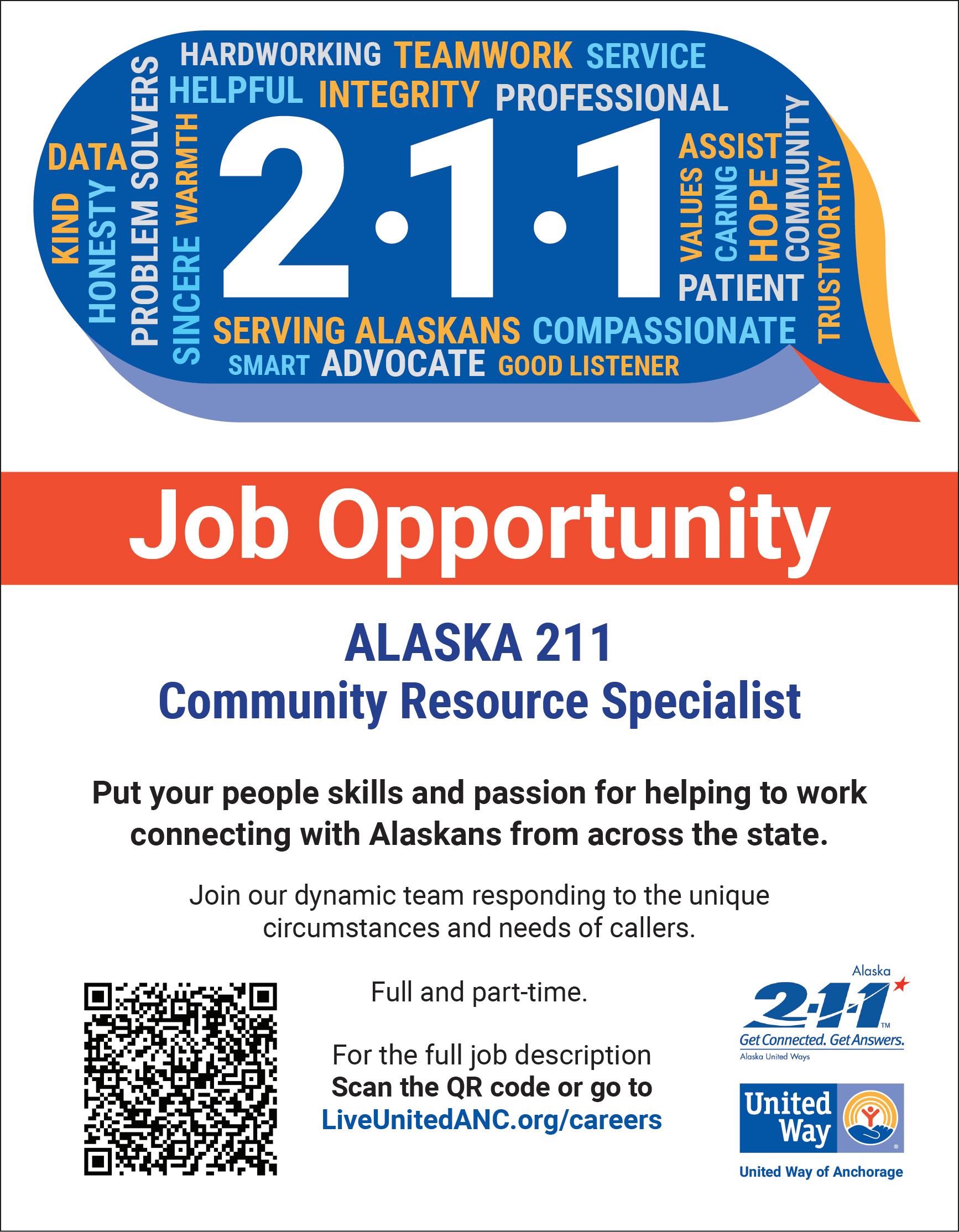
The ladies entered the second quarter with a 29-10 lead over the opposing team.
The Seawolves played great team basketball during the second quarter, with seven different players adding points to the scoresheet. UAA entered halftime with a 48-26 advantage over the Wolves.
Oregon managed to fightfit their ways back to a 13 point deficit with two minutes left until the fourth quarter, but that’s the closest the Seawolves allowed them to get. UAA led 64-48 entering the final quarter.
Despite already leading by 16 points, the Seawolves contin-
ued to play hard and extend their lead. Rabb scored six points into the final period to work her way up to 29 points, and the Seawolves won the game 80-58. Jazzpher Evans was the second highest scorer for the Seawolves with 13 points, and Robertson took the number three spot with 12 points.
Riding the high of a three game win streak, the Lady Seawolves are ready to compete at the Great Northwest Athletic Conference championships in Bellingham, Washington from March 2-4. Visit GoSeawolves. com for more information about the tournament.
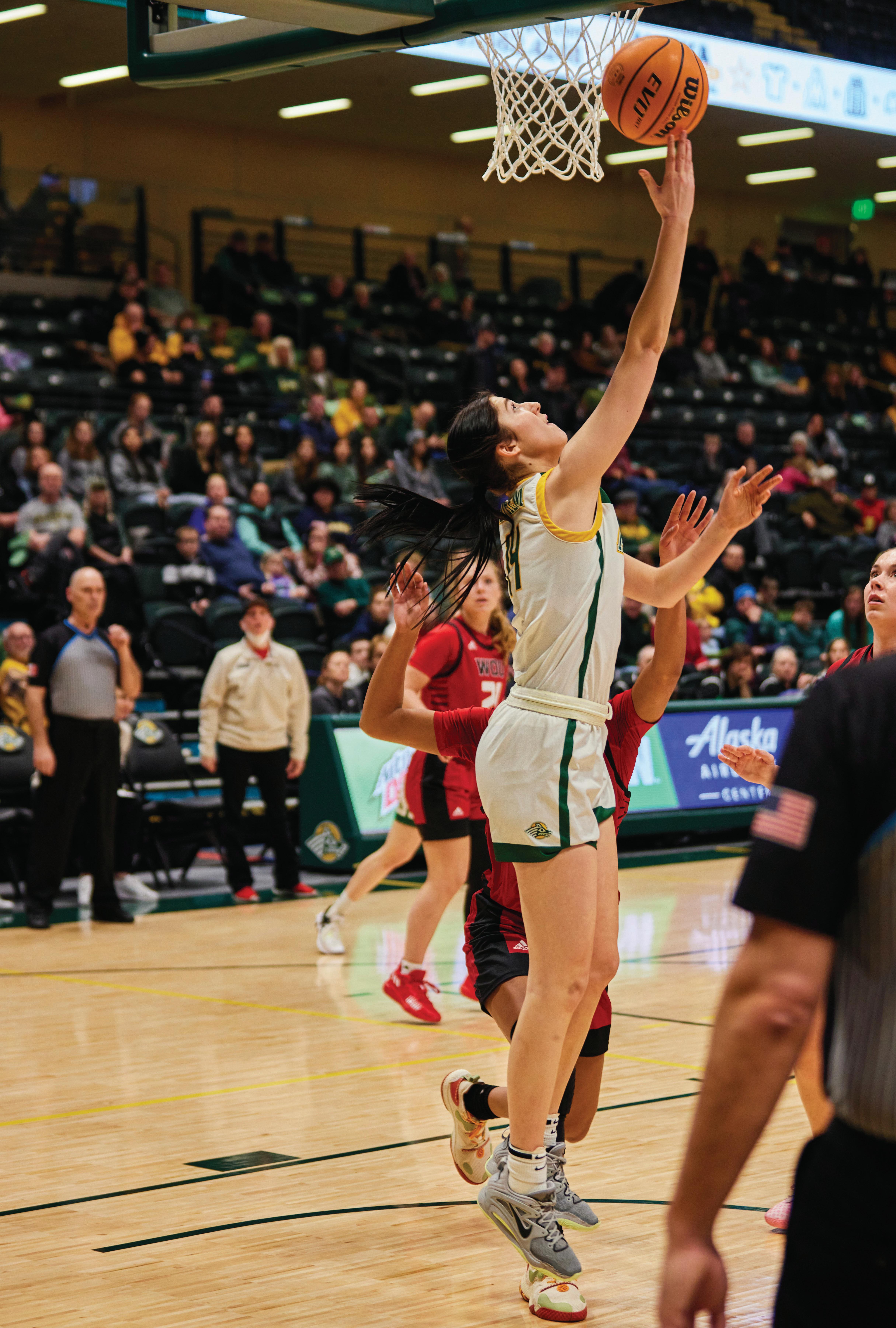
Multiple fights break out between UAA and ASU in the first Seawolf home game since January.
By Avery Williamson sports@thenorthernlight.org
The Seawolves were unable to connect with the net as they faced off against the Arizona State University Sun Devils on March 3 at the Seawolf Sports Complex. The opposing team skated off the ice with a 5-0 blowout win against the hosts.
The Seawolves won the first face off and quickly set up a play on offense. Tough defense by the Sun Devils kept the puck out of the goal, though.
Both teams played impenetrable defense for the first 11 minutes of the game, but the Sun Devils found their way to the net with several fast-paced passes. Arizo -
na State led 1-0 with just over 10 minutes left in the first period.
The Sun Devils found themselves in the penalty box three minutes later for slashing. With a 5-4 player advantage over the visitors, the Seawolves played aggressive offense, taking several shots in just a few minutes. However, Arizona State’s penalty ended before the Seawolves could connect with the net.
The rest of the first period featured multiple shot attempts by both teams, but neither were able to score. The Seawolves entered the second period with a 1-0 deficit.
After winning the first face off of the second period, the Sun Devils made a series of quick passes to make their second
By Avery Williamson sports@thenorthernlight.org
The Seawolves delivered a 76-66 win over the Central Washington University Wildcats on Feb. 4 at the Alaska Airlines Center. Two dunks by Sawyer Storms helped the team gain momentum and secure the victory.
The Seawolves played with intensity from the tip off, with Lachlan Viney driving the paint and scoring a layup only 23 seconds into the game.
After playing tight defense on the Wildcats, AJ Garrity scored a layup of his own, and a minute later Tyson Gilbert drilled a three-pointer to put the Seawolves up 7-0.
The Wildcats put themselves on the scoreboard with two free throws after a foul by Garrity. But the Seawolves responded with a layup by Viney and a three-pointer from Dathan Satchell.
With six minutes left in the first half, the Wildcats passed the ball around and tried to set up a play. Storms anticipated the pass and snuck his way in for a steal.
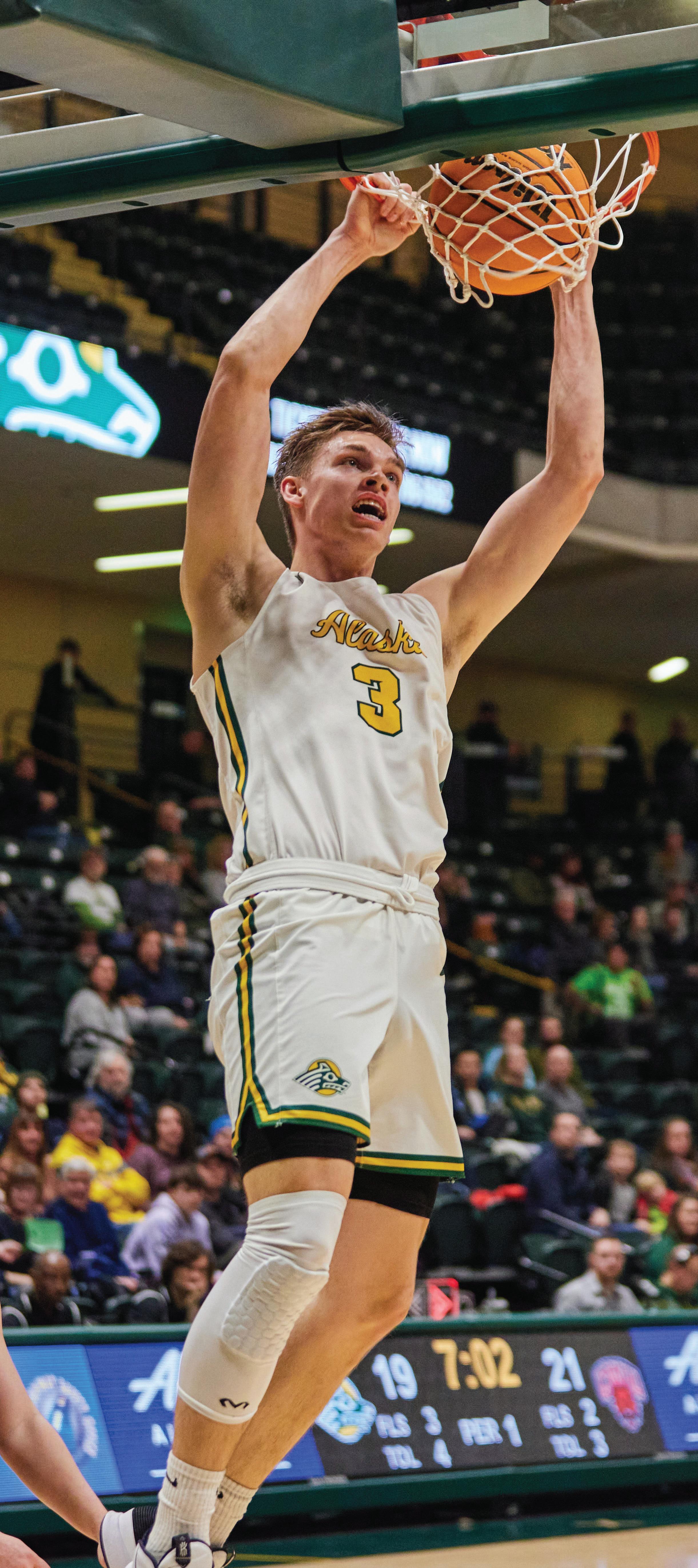
goal of the game. UAA trailed 2-0.
The Seawolves found themselves in a tough spot two minutes later after they were penalized for slashing and roughing. Arizona State began a 5-3 power play.
With only three players on defense, the Seawolves managed to lock down the Sun Devils. Their impressive defense helped them steal the puck and make a run for a goal of their own.
After securing the puck, Caleb Hite skated his way to Arizona State’s goal. With no one in front of him, he set up a shot and fired. However, Sun Devils goalie Ben Kraws was able to block the shot, and the Seawolves remained scoreless.
Back at full strength, the Seawolves played aggressive offense. Within 40 seconds, they took four shots, but Kraws saved the puck each time.
With ten minutes left in the second period, the Sun Devils found their way to the goal and gained a 3-0 advantage over the Seawolves. The rest of the second period remained scoreless.
The final period featured several fights between the two teams. As each fight broke out, the crowd cheered for the Seawolves and screamed profanities at the
Sun Devils. The referees spent the final 20 minutes forcing their way between punches.
Arizona State seemed unfazed by the aggregation, though. Five minutes into the third period, they scored their fourth goal of the game.
The Sun Devils were soon penalized for hooking, and UAA entered a power play. The Seawolves were able to fire several shots, but Kraws continued to make saves. When the Sun Devils returned to full strength, they were still leading by four points.
Carson Kosobud was then penalized for hooking, and Arizona State entered a power play. One minute later, they found their way to the goal yet again and gained a 5-0 advantage over the Seawolves.
The Sun Devils’ fifth goal concluded the scoring for the game. The Seawolves skated off the ice with a 5-0 defeat.
The Seawolves return to the Seawolf Sports Complex on March 10 and 11 to take on Lindenwood University in the final home games of the season. Head to ice at 7 p.m. Alaska Standard Time on Friday and 6 p.m. Alaska Standard Time the following day to cheer on the pack.
He drove up the court with CWU players at his heels. He didn’t let this stop him, though. Instead, he pushed the pace and delivered a powerful dunk.
The crowd broke into celebration, cheering at the top of their lungs for the team. The Wildcats called a timeout to collect themselves, and the crowd continued to cheer until the ball was back in play.
CWU’s timeout appeared to have paid off, because they began sinking all their shots. With 10 minutes until halftime, they took their first lead of the game 1716.
The Wildcats extended their lead with a fast break layup. The Seawolves didn’t give up, though. Instead, Viney drilled a three-pointer to tie the game at 19.
CWU quickly took the lead back with another layup. But then history repeated itself.
The Wildcats set up another play that Storms ruined. He stole the ball, drove the court, and slammed down another dunk to tie the game at 21.
Once again, the crowd erupted in cheers, and this time, everyone jumped onto their feet. Even the players cheered as they sprinted down the court to play defense.
Storms’ second dunk of the night helped the Seawolves build the momentum they needed. After the dunk, they began to make all their shots. By the end of the first half, they had developed a 4031 lead.
The Seawolves continued to drill their shots in the second half. Storms drilled a jumper, followed by three-pointers from Gilbert and Viney. Viney then sank both his free throws after being fouled.
In just over a minute, Gilbert, Satchell and Jaedon Bradley each drilled a threepointer to extend UAA’s lead to 62-40.
With nine minutes left in the game, the Wildcats were desperate to come back. A foul by Garrity allowed them to get back their momentum. They began to drill their shots.
CWU fought their way to a 10-point deficit, but it was too late. The lead the Seawolves created earlier in the game was too big to conquer, and UAA won the game 76-66.
Viney led the Seawolves with 21 points and six assists. Gilbert and Storms both finished the game with 13 points, and Storms also dominated with seven rebounds.
The next Seawolf home games are on Feb. 16 against Saint Martin’s University at 5:15 p.m. and Feb. 18 against Western Oregon University at 7:30 p.m. Visit GoSeawolves.com for live links and stats.
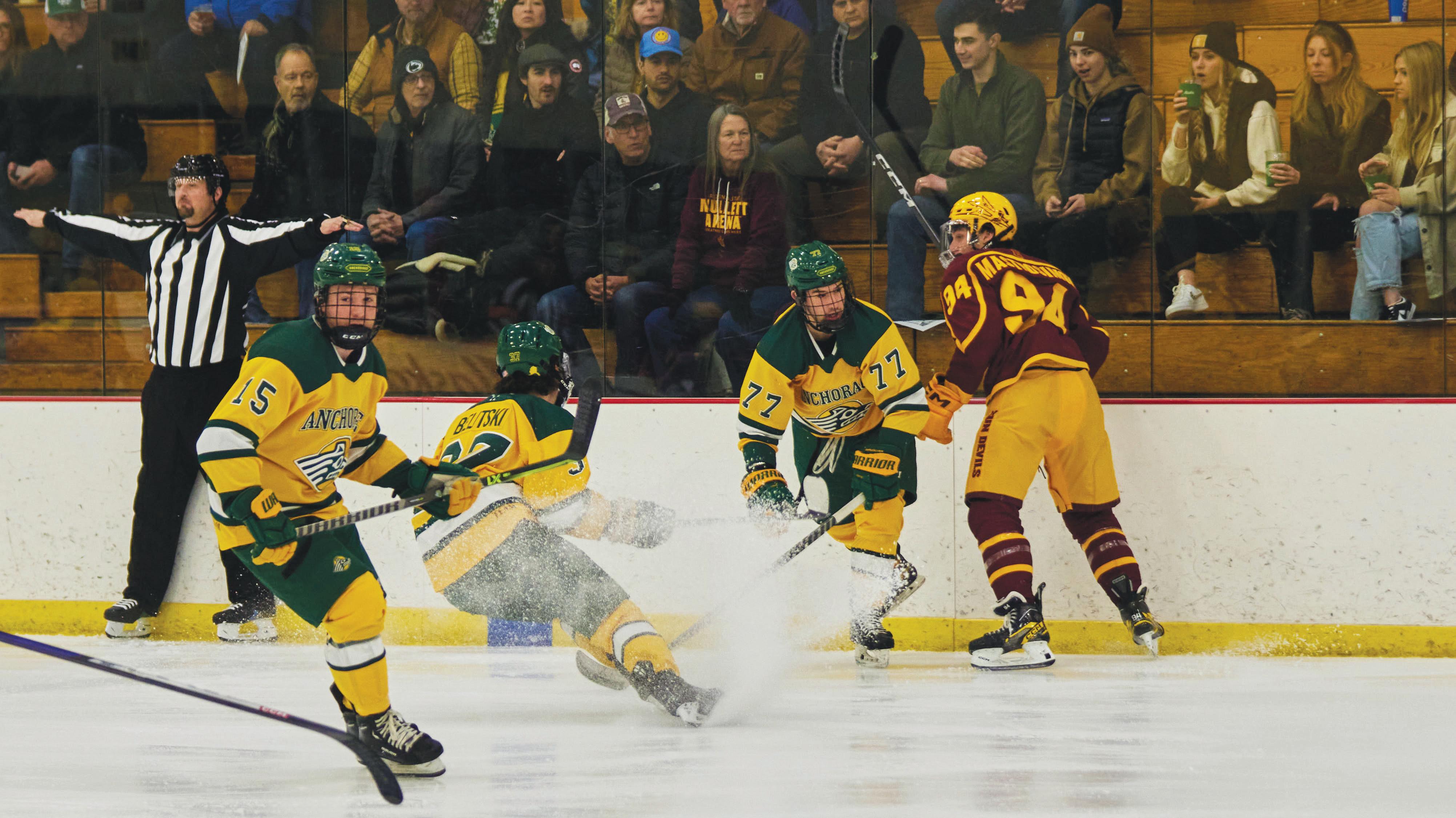
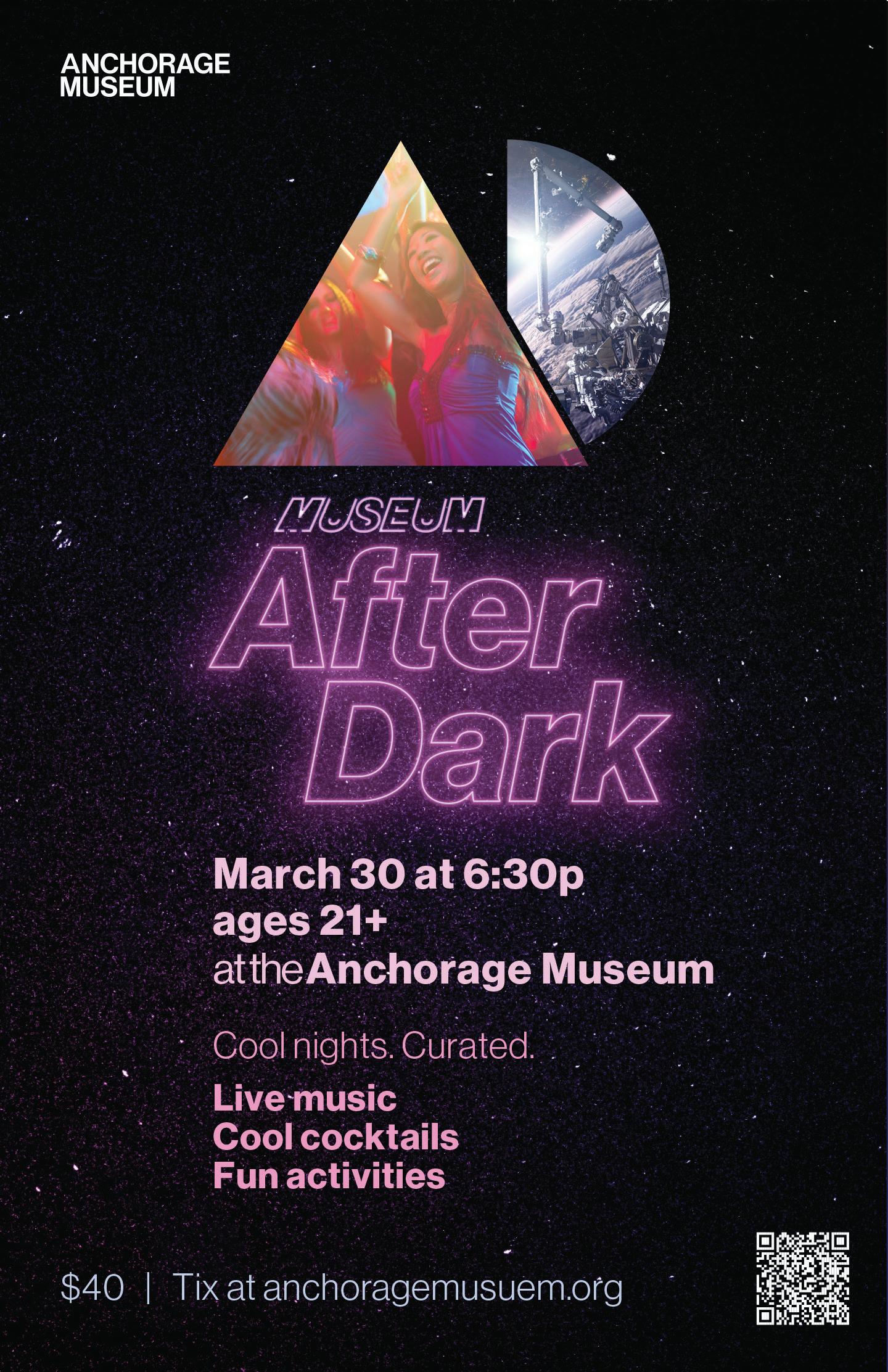
By Avery Williamson sports@thenorthernlight.org
After six lead changes and four ties, the Seawolves secured a 76-63 victory over Saint Martin’s University at home on Feb. 16. Jahnna Hajduckovich led a third quarter surge – scoring 18 points in 10 minutes – to help carry the Seawolves to their 13-point win.
The opposing team was first to shoot, but tight defense by the Seawolves prevented a bucket. Vishe’ Rabb secured the rebound, drove the court and put UAA on the scoreboard with a layup.
The Seawolves maintained their intensity and quickly grabbed a nine point lead over the Saints. But UAA soon struggled
to make their shots fall, and the Saints came back to tie the game 15-15 with 56 seconds left in the first quarter.
Saint Martin’s then took the lead with a threepointer with 18 seconds until the buzzer. Rabb pushed the ball down the court and got fouled with five seconds left in the quarter. After making both free throws, the Seawolves trailed 17-18 going into the second quarter.
Several Seawolf turnovers early in the second quarter helped the Saints extend their lead to six points. Once again, UAA struggled to make their shots, but a three-pointer by Elaina Mack helped them get back their momentum.
The Seawolves took the lead after Jazzpher
Evans sunk a three-pointer, but the opposing team snatched the lead right back with a three-pointer of their own.
The teams continued to trade leads until they tied at 29-29 with 45 seconds left until halftime. Kimani Fernandez secured a rebound, passed up-court to Rabb, and Rabb dibbled her way to a layup. The Seawolves led 31-29 going into the locker room for halftime.
The third quarter was led by Hajduckovich, who made four three-pointers, four free throws, and one jumper, for a total of 18 points. Hajduckovich shot an impressive 50% from the three-point line. By the end of the third quarter, the Seawolves led 6448.
The Seawolves contin-
ued to play tight defense throughout the fourth quarter, holding the Saints to 13 points. UAA won the game by 13 points.
UAA held the opposing team to 37.7% shooting, while the Seawolves shot 46.6%. Rabb led the team with 25 points and 10 rebounds, and Hajduckovich recorded 18 points – all in the third quarter.
The Seawolves compete in their last games this upcoming week before the Great Northwest Athletic Conference championships . They’ll take on Seattle Pacific University on Feb. 23 at 6:30 p.m. Alaska Standard Time and Montana State Billings on Feb. 25 at 5:30 p.m. Alaska Standard Time. Visit GoSeawolves.com for live links and stats.
By Avery Williamson sports@thenorthernlight.org
Despite a late comeback in the fourth quarter, the Seawolves were unable to defeat Saint Martin’s University. UAA fell 8273 on Feb. 16 at the Alaska Airlines Center.
Tyson Gilbert put the Seawolves on the scoreboard with a layup, and AJ Garrity added three more points with a deep threepointer. But the Saints were quick to tie the game with a layup and threepointer of their own.
The Seawolves then struggled to knock down their shots, and the Saints took a 21-11 lead with 11 minutes until halftime. A layup by Jaron Williams, though, helped UAA re -
gain their momentum.
UAA then began to outrun the winded Saints, which led to a fast break layup by Luke Devine, followed by a three-pointer by Garrity.
Gilbert then knocked down two consecutive three-pointers, and two free throws made by Garrity got the Seawolves within eight points with four minutes until halftime.
Both teams continued to knock down shots for the rest of the first half.
The Seawolves trailed 3241 going into the locker room.
The Saints dominated the first five minutes of the second half, outscoring the Seawolves 16-5 within just a few minutes. UAA refused to give up, though.
Lachlan Viney began to drive to the basket aggressively, which forced the opposing team to foul him. Viney sank both his free throws, then returned to the free throw line to make two more shots after another aggressive drive.
Trailing by 24 points, Jaedon Bradley also began to play more aggressively. In just over two minutes, he scored 10 points to get the Seawolves within 17 points.
With two minutes left in the game, the Seawolves began to comeback. Williams, Gilbert and Devine found their ways to the basket to get within 10 points with 33 seconds left in the game. Caleb Larsen concluded the scoring with a threepointer. The Seawolves
lost by nine points. Gilbert led the Seawolves with 18 points, followed by Garrity and Bradley with 14 points each.
With a 6-9 record in the Great Northwest Athletic Conference and less than two weeks until the GNAC tournament, the Seawolves are looking to improve their record.
They’ll have the chance to add two more wins with their away games–one against Seattle Pacific University on Feb. 23 at 4:15 p.m. Alaska Standard Time and one against Montana State Billings on Feb. 25 at 3:15 p.m. Alaska Standard Time. Visit GoSeawolves.com for live links and stats.
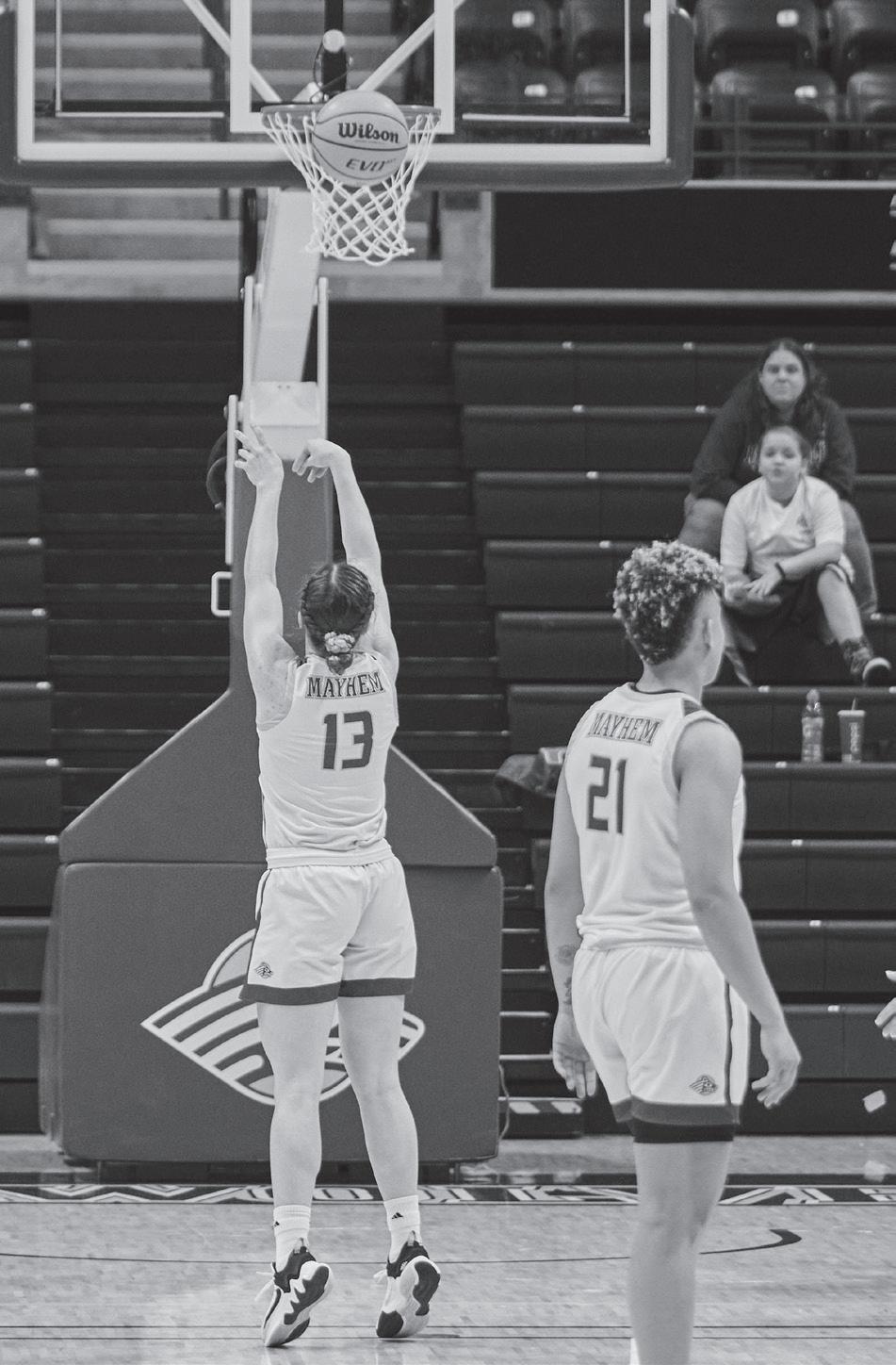

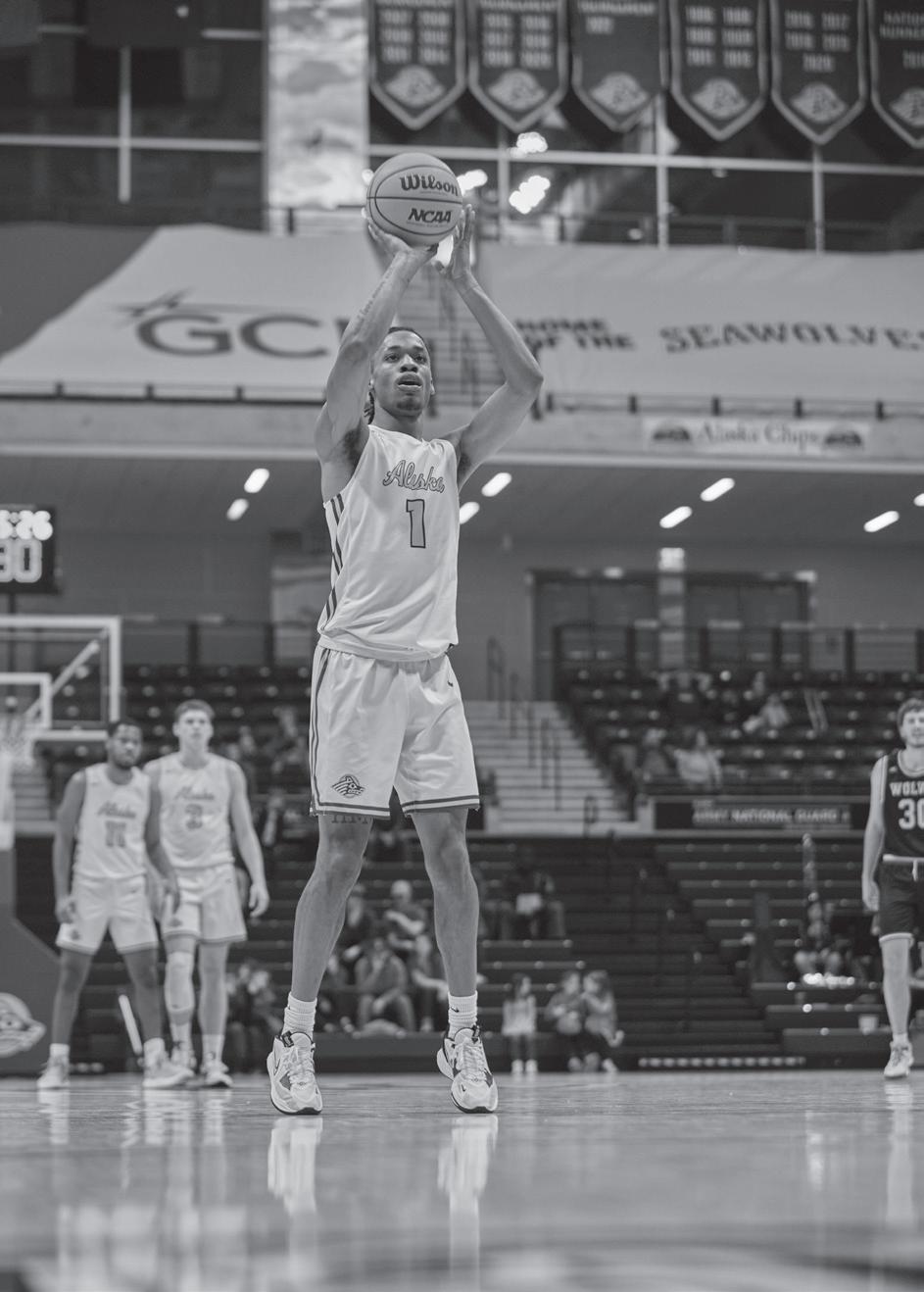
At the last home games of the regular season, fans were on the edge of their seats watching a close game until the very end.
By Avery Williamson sports@thenorthernlight.org
After a close 40 minute battle featuring ten ties and eight lead changes, the Seawolves had a heartbreaking loss to the Western Oregon University Wolves at home on Feb. 18. The men fell 74-69 despite four Seawolves scoring in the double digits.
The opposing team set the tone for the game, sinking a shot only 18 seconds after the tipoff. UAA responded though, with AJ Garrity drilling a shot of his own.
Trailing 8-2, the Seawolves pushed the ball down the court, and Garrity found Sawyer Storms in the paint for a dunk.
The Seawolves took their first lead of the game
with a little under 14 minutes left in the half after Garrity drilled a three pointer. However, Oregon took the lead back one minute later with a layup.
The teams continued the trade leads until Oregon gained momentum, scoring a three pointer and layup back-to-back to lead 24-19. The Seawolves pushed their way back to a tie game after a three pointer by Jaedon Bradley.
Trailing by four points with 55 seconds until halftime, Jaron Williams used his ball handling skills to push his way into the key and score a layup. The Seawolves trailed 36-34 entering the locker room.
The Seawolves took the lead back three minutes into the second half with a three pointer by Dathan Satchell.
The next four minutes featured three ties, but the Seawolves prevented Oregon from taking the lead. Both teams entered a dryspell with just under 12 minutes left in the game, with neither team scoring for three minutes.
Bradley broke this dryspell for UAA with a layup and the Seawolves extended their lead to 52-47. Two made free throws by Storms and another three pointer by Bradley helped UAA gain an eight point lead, their largest of the night.
The Wolves fought their way back into the game, though, and teams were tied 63-63 with 50 seconds left until the final buzzer.
Neither team was able to score in the final 50 seconds, and the Seawolves headed into a five-minute overtime period.
Oregon scored six
straight points in the first three minutes of overtime. Trailing 69-65, Lachlan Viney worked to get the Seawolves back into the game with a layup. Garrity then drilled a three pointer to get UAA within one point.
The Seawolves were unable to combat Oregons’s sharp-shooting, though, and they fell 7469.
Tyson Gilbert and Viney led the Seawolves with 13 points a piece, and Bradley racked in 10 points of his own. Storms led the team defensively with seven rebounds.
The Seawolves head to Bellingham, Washington soon to compete in Great Northwest Athletic Conference championships from March 2 to 4. Visit. GoSeawolves.com for more information about the tournament.
Benson advises new students: “Don’t be apart from your school, be a part of your school.”
By Kaycee Davis features2@thenorthernlight.org
Gregory Benson has followed a nonlinear path in his life and education, like many students at UAA. He shared with TNL his experiences in the military and challenges returning to school as a nontraditional student. I met Benson at UAA’s Engineering Department Club Showcase. As the Project Management Club president, he was in a classroom where he was leading a project trivia game, where the points didn’t matter, but the subjects were interesting.
He was excited with every correct answer. As my group moved on to the next event, I hung back and we talked. He told me about how much he loved his program, that he wasn’t a sciences major but that in project management, “you need to understand what everyone is doing and secure permits, permissions, and make sure everyone is happy.” He spoke of the military, his jobs, and told me that he was a veteran who had worked toward veteran success, and that he also thought it applied to success in life.
In a follow-up interview via Zoom, I found out that he is a graduate student studying project management, but him being at UAA working on a master’s de -
gree in something he loved wasn’t something that happened overnight.
The child of a father who was an Army reservist who had lived in Detroit, Baltimore, and graduated from high school in tiny Vilonia, Arkansas, he joined the military as soon as he got out of high school, intending to make it his career.
A line by Christopher Schoeder aptly describes the experiences of Benson: “Life isn’t an arrow, it’s a sine wave” with ups and downs, oscillating in ways he could have never predicted.
After joining the U.S. Army, he got married and completed three tours in Iraq and Afghanistan– he told TNL that he spent 39 months in combat zones. “The tours took a toll,” he said. “When you are over there, you can’t wait to get back home and when you come back, you miss your people.” He explained that when you are preparing for battle, “you bond with your troops through eating together, training together, protecting each other– even though it is stressful, there is a sense of a mission and of belonging. You are willing to die for them and they are willing to die for you.”
After coming home, his first marriage ended. At a time when he needed to be with his wife, the military wanted
to transfer him yet again, this time to Alaska. The effects of war and his having spent so much time away took a toll on their marriage. “We are still good friends,” he said.
With time and therapy came healing–and a second marriage. Benson said, “Carin is my best friend and partner. None of the second act of my life would be possible without her in it. This is not my story, but our story.” They decided to go down to Weber State University in Utah where he would get a degree in public relations and advertising. The job that he had arranged to get did not work out.
Greg said that when he got to Weber, he was older than most of the students and he “felt like an outsider”. One night he went to a football game and he saw some fellow public relations majors up in the stands.Being older and a vet he said had always felt different, but went to sit with them anyway. “We screamed for the football team as Wildcats. That night, I became part of the school. After that, I wasn’t the old guy, or the vet, I was the chillest dude in class, working on my degree like everyone else.”
After that, he became more involved at Weber and started a veteran’s organization aimed at helping vets integrate into student life. For his personal growth, he said “my time at Weber State means as much to me as my time in the Army.” He shared with TNL the 3 Pillars to Succeed that he shared with the vets: 1. Family–
By Jasmine Grant news@thenorthernlight.org
The annual Bettye Davis Summit commenced on Feb. 18 at East Anchorage High School. The summit is run by Alaska Black Caucus, a reestablished community activism group.
The summit is named after late state senator Bettye Davis who served as ABC Chair of the Board. It provides a platform for discussion between professionals and the public on community issues.
The summit held four public forums including an Economics Business Marketing forum, a Healthy U forum, an Education forum, and a Justice and Policing forum.
The Education Forum held a conversation on race and education with ASD superintendent Jharret Bryant and Judge Pamela Washington. Teacher and ABC’s Education Chair Jessica Cook led the
talk.
The Healthy U forum featured a number of local health professionals including two UAA faculty members, Rei Shimizu and Amana Mbise, both Assistant Professors in the school of Social Work.
This interactive forum focused on addressing the health needs of people of color. There were many other healthcare and wellness vendors present at the summit as well.
One vendor represented the recently established family practice clinic AlaskaVIP Health & Wellness. Aderonke “Ade” Akindipe said she saw the need for resources in Anchorage.
“Where I came from I noticed that gap, that sometimes the care is not necessarily individualized. It’s just based on the normal values,” she said, “And I don’t believe that there is a normal value for everyone.”
Akindipe said care needs to take into account a patient’s background and envi-
ronment. “I think when people feel like you hear them, it makes them feel better already,” she said.
According to the president and CEO of the Alaska Black Caucus, Celeste Hodge Growden, nearly 70 vendors were in attendance. The The ABC Economics Committee aims to economically empower black people. The committee led the Business Marketing forum with state offices.
Civil rights organizations such as the Anchorage NAACP and ACLU of Alaska were present.
The Anchorage NAACP had open recruitment for new members, including its youth program. Ashleigh Gaines, Chair of the Anchorage NAACP Youth Council, named a number of youth programs investing in black futures.
“The Act-So program is an academic enrichment program for high school students,” Gaines said. Students are men-
you belong to them, and they to you. 2. Purpose– Everyone who is successful has a mission with planning, a way to make it happen, and a completion. 3. Camaraderie– a spirit of trust and friendship between people who share the mission.
When he and Carin came back to Alaska, he wanted to get a job in his field, but even as a veteran with a college degree, he had no experience in his field. “So I checked out UAA. I still had veteran’s benefits.”
A chance meeting with LuAnn Piccard had him sold on the master’s degree in project management. “LuAnn is amazing, inspirational. She and Roger Hall [another professor in the department ] love their students. People stay in touch with them and call them.” It was LuAnn’s idea to get a project management club started– this club is sanctioned by the Project Management Institute. He says there are seven student members, but that right now there are no competitions as there are in say, robotics. Benson said he is hoping that they will have their first meeting in March.
He said that whether one is a vet or a brand new student, that they should start by going for an associates of arts degree, “check out different classes and fields” to see what they like. He told TNL that if a new student just doesn’t feel like they belong, “getting involved is key to belonging. Don’t be apart from your school, a part of your school.”
tored in special interests to compete locally and nationally for college scholarships, she said.
Gaines said being a member means exposure and education on black American history and civil rights. “Like any other city, we have our own history, our own legacy.”
The NAACP helped host the Justice and Policing Forum which held a conversation about the recent police killing of Tyre Nichols in Memphis.
“I was appalled that it was five black officers involved,” one commenter said, “I was equally appalled to see the administration’s response to those black officers.”
“We’re taking what we learned from all of these experts in the various areas of health, education, economics, injustice, and moving our communities forward,” Growden said, “we can’t stay where we are.”
The Alaska Black Caucus will host multiple community conversations on zoom in March.

By Kaycee Davis features2@thenorthernlight.org
According to the Centers for Disease Control,a traumatic brain injury “is an injury that disrupts the function of the brain. It can be caused by a bump, blow, or jolt to the head or a penetrating head injury.”
According to the CDC, 2% of Americans are living with a brian injury. While the percentage may seem small, the actual number, 5.3 million, is high. The website says that “each year an estimated 1.5 million Americans sustain a traumatic brain injury (TBI) and as a consequence of these injuries: 230,000 people are hospitalized and survive, 50,000 people die, 80,000 to 90,000 people experience the onset of longterm disability.”
If you live in Alaska, you are more likely to suffer a brain injury. The Brain Injury Association of Alaska website says that 10,000 Alaskans are living with a disability caused by brain damage, and 800 Alaskans are hospitalized each year for brain injuries. Two hundred fortyseven Alaskans who have a TBI, or 38%, become permanently disabled, and 150 die each year from the injury.
Blasts are another cause that have had an especially heavy impact on members
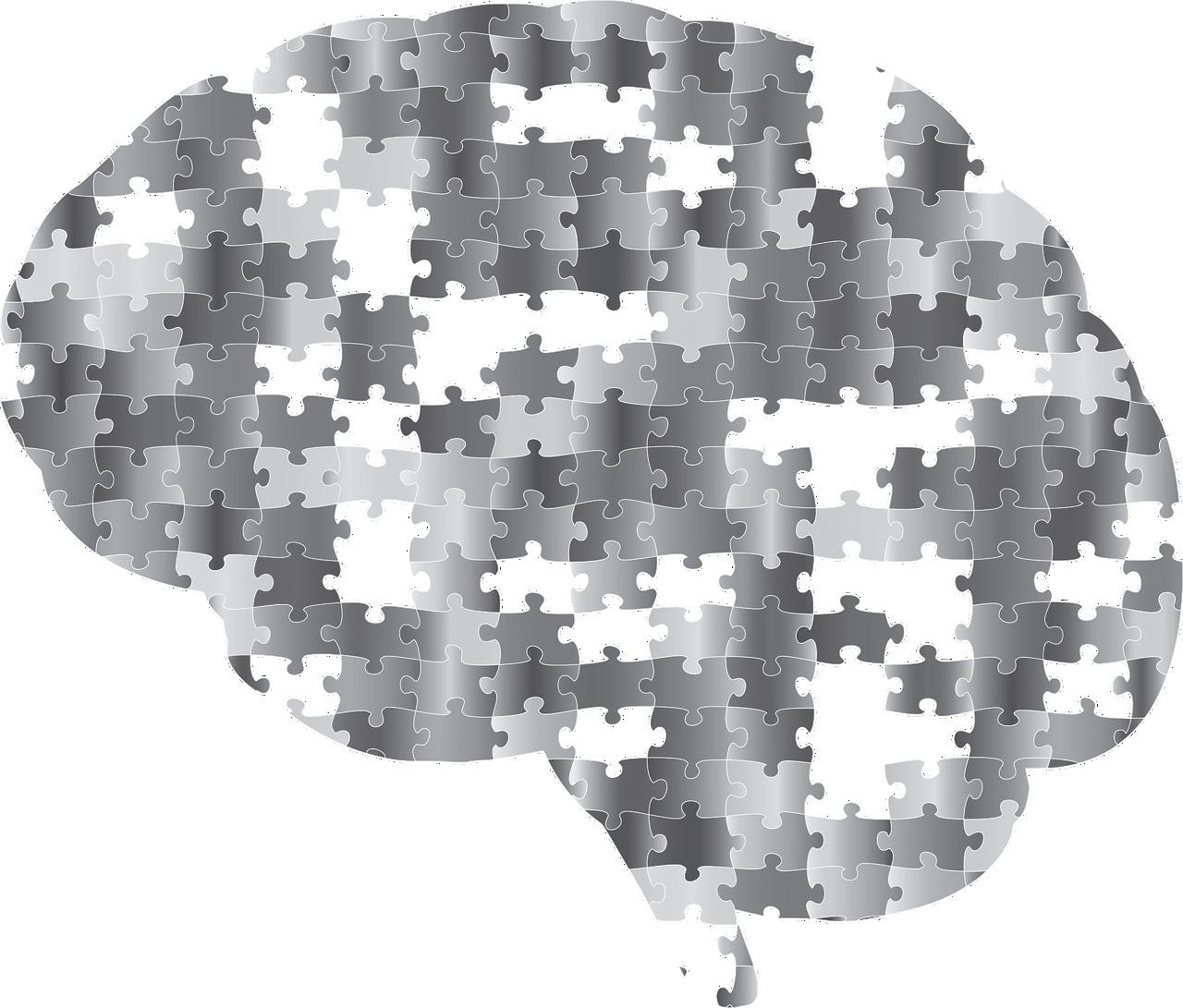
of the US military. Mayo Clinic says that “Explosive blasts are a common cause of traumatic brain injury in active-duty military personnel.”
The CDC has revealed that it is difficult to assess the number of actual TBI and other brain injuries These numbers “do not account for those persons who did not receive medical care, had outpatient or office-based visits, or those who received care at a federal facility, such as persons serving in the U.S. military or those seeking care at a Veterans Affairs hospital.”
Minor brain injuries can resolve themselves, but some do not. Mild and severe brain injuries take longer to resolve. There is the initial injury which is physical, and then it may take days or months or
even longer to see how the damage affects the person.
No matter where you are when you get it, or how you get it, brain injury is a tragedy. There are two main brain injury types: congenital brain injuries that occur in the womb and acquired brain injuries, which is what this article will focus on.
According to Brain Injury Awareness Association of America, acquired brain injuries are “not hereditary, congenital, degenerative, or induced by birth trauma.” There are two types of ABI: nontraumatic brain injuries and traumatic brain injuries.
A nontraumatic brain injury “causes damage to the brain by internal factors, such as a lack of oxygen, exposure to toxins, pressure from a tumor,
etc.“
A traumatic brain injury is defined as “an alteration in brain function, or other evidence of brain pathology, caused by an external force. Traumatic impact injuries can be defined as closed (or nonpenetrating) or open (penetrating).”
So how does Alaska fit into all this? According to the The Alaska Brain Bus website, “Brain injuries are a fact of life, and death, on the last frontier.”
The Brain Bus is a group aiming at improving the lives of “community members and their families impacted by traumatic brain injury” and are part of a shared mission with the Alaska Brain Injury Consortium. They received a grant from the Mental Health Trust Authority to help fund their work related to TBI in Alaska.
Because of Alaska’s size and sparse population, access to training and education can be difficult, so awareness and diagnoses at faraway, off the grid medical clinics can be a challenge. Sometimes it takes days, weeks, and even months to recognize the problems caused by brain damage, and someone living in a sparsely populated area might not want to spend the money to travel into hub cities to get a medical diagnosis.
Treatment in Alaska is also difficult. The Brain Bus website indicates that possibly 75% of people with brain injuries do not get medical care, and stud-
“Chasing the Ghost Particle: from the South Pole to the Edge of the Universe” is but one of many great shows.
By Kaycee Davis features2@thenorthernlight.org
UAA has a lot of activities that are recurring and habit forming. One of my favorites happens most Friday nights at the Planetarium & Visualization Center. There, an immersive experience awaits viewers.
On January 27, I went to see “Chasing the Ghost Particle: from the South Pole to the Edge of the Universe.” The plan was to see “Phantom of the Universe” first, but I got there late. When they say they will shut the doors ten minutes before the showing, they mean it. And I understood once I was inside: The experience of watching a show on a dome cannot be interrupted with people entering,exiting and finding their seats. The movie can be seen on YouTube,
but it is a different sensory experience to see it on a 10-meter dome, sitting in an angled chair and looking up. With the space shots, it is easy to forget that you are sitting inside a theater.
“Chasing the Ghost Particle” is about IceCube, “the biggest and strangest [astronomical] detector in the world.” Unlike space telescopes, which most people would expect to be on a mountaintop, IceCube is buried deep in the ice of Antarctica. Telescopes normally look at light from stars, but IceCube looks for neutrinos.
The IceCube Neutrino Observatory website describes neutrinos as “nearly massless subatomic particles that are electrically neutral. They can travel at nearly the speed of light from the edge of the universe without being deflected by magnetic fields or absorbed by mat-
ter. They travel in straight lines from their source. This makes them excellent messengers of information about the objects or events in which they originate.”
The film takes viewers from space to Antarctica where the scientists and workers who designed and made the neutrino observation device speak about the making of it. Images
of scientists in their labs come up as they share facts and observations. There are a surprising number of scenes where there is no talking, and one sits back and “travels.” One scene takes viewers on a journey to the earth, starting on the outer edge of our solar system. We pass planets and get closer to the sun but stop at Earth. As the camera angles down, we learn of the many telescopes, but how “only
ies show that people with brain injuries are more likely to lose their jobs and struggle with employment, abuse substances and go to jail.
According to the “Alaska State Plan for Brain Injury” put out by the Alaska Traumatic and Acquired Brain Injury Advisory Council, “screening data in Alaska is limited,” but from 2006 to 2017, there was a screening tool for people seeking behavioral health services with two questions pertaining to brain injury. The questions asked if an individual had ever had a “blow to the head” severe enough to make them lose consciousness and if they’ve had a “blow to the head” severe enough to cause concussion.
In 2017, “over 40% of individuals accessing behavioral health services had experienced a brain injury during their lifetime, as indicated by a “yes” response to one or both of the brain injury screening questions.”
Adam Grove is a part of The Alaska Brain Bus and sits on the Alaska Traumatic and Acquired Brain Injury Advisory Council. He told TNL in an email that “existing data shows that falls and ATV/snowmachine accidents are the leading cause of brain injuries in native and nonnative Alaskans. Our climate and weather conditions combined with high levels of participation in outdoor activities lead to increased falls and our re -
one” is buried in one cubic kilometer of ice. Viewers learn of the “wide net” that must be cast for IceCube to capture images, and why it must be huge and in the dark. Through this imaging, there is a feeling of comprehending the vast area that scientists had to consider when building the observatory.
Viewers are taken into deep holes 2.5 kilometers under the ice and learn that “over 5,000 light sensors called ‘Doms’ were lowered and locked into place.” The narrator says that IceCube is taller than the Statue of Liberty and the Eiffel Tower. IceCube is a gigantic cube of ice, a kilometer on every side”. While Earth is constant-
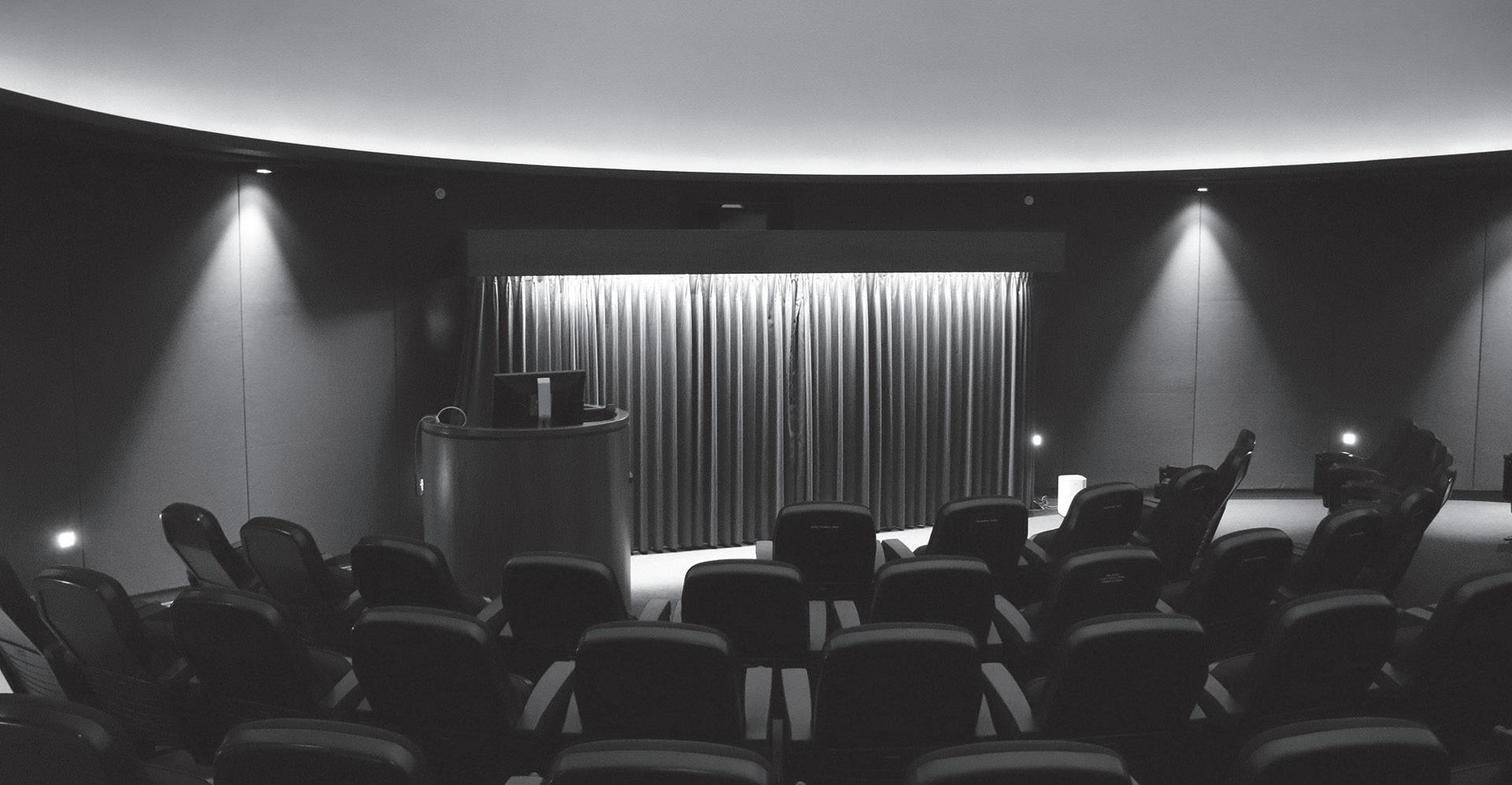
liance on snow machines and ATVs in many parts of the state means we’ll see more accidents there.” He also emphasized the value in wearing ice cleats and helmets as “simple steps to reduce the rates of injury.”
On the Alaska Brain Injury Associtaiton’s website there is a document that explains the functioning of the brain after TBI: “A traumatic brain injury interferes with the way the brain normally works. When nerve cells in the brain are damaged, they can no longer send information to each other in the normal way. This causes changes in the person’s behavior and abilities.”
The initial impact has a chain reaction that reverberates through the person’s life.
Alaska, which is strained in brain injury recovery because of lack of care, untimely care, and frequent misdiagnosis, is also short changing brain injury patients with having no facility specifically planned for TBI patients, with specifically trained medical doctors and staff.
The Alaska Traumatic and Acquired Brain Injury Advisory Council has a detailed plan for brain injury treatment that will “develop infrastructure in Alaska to support the healthcare and community rehabilitation needs of Alaskans recovering from brain injury and reduce the number of people being discharged home with no follow up.”
ly getting bombarded by neutrinos, “IceCube is looking for high energy neutrinos and it looks in all directions, all the time.”
The movie shares the details of the construction and planning, and why neutrino study is important. Two hundred fifty researchers from 41 institutions and 12 countries contributed to the making of the observatory, including Dr. Katherine Rawlins of UAA, who spoke and ran a Q & A session at the end. Viewers asked diverse questions about other neutrino observatories, where they come from and if some events make more than others, and what affects neutrinos. Dr. Rawlins was positive after the show and said “they asked some good questions.”
While “Chasing Ghost Particles” is not scheduled to be seen again on the dome this semester, the UAA Planetarium has a schedule of shows planned through April. Check it out and be sure to buy your tickets through UAA Tix in advance. There is a discount for UAA students with valid IDs. Parking is not complicated, but if you have never been to the shows before, it helps to plan for extra time and to know where you will park.
By Timothy A. Wittenberg
arts2@thenorthernlight.org
As the recently hired arts and entertainment reporter, I thought it’d be the right thing to try and see what people on campus are looking for in terms of art. What better way to know than to ask? I originally had thought up doing some form of observing or interviewing, but this would have taken far too long; plus many people on campus are too busy for something like that. The final product was a questionnaire.
The questionnaire itself was divided into four sections: the intro, art, entertainment, and an additional comments section. All of the questions were optional.
The goal with the art section was to try and cover all of the way art is expressed. I focused more on the broader strokes of art, like the genre and movements within the arts.
The answers to this section seemed to have mixed results. It’s about 50/50 on whether or not there are people interested in any form of artistic movement. This trend followed through until the writing portion of this section.
3211 Providence Drive Student Union 113 Anchorage, AK 99508
Executive Editor Matthew Schmitz (907) 786-1313 editor@thenorthernlight.org
News Editor Taylor Heckart news3@thenorthernlight.org
Sports Editor Avery Williamson sports@thenorthernlight.org
Audio Editor Jasmine Grant news@thenorthernlight.org
Video Editor Eli Rupp video@thenorthernlight.org
Copy Editor Rico Torres copy@thenorthernlight.org
A&E Reporter Timothy A. Wittenberg arts2@thenorthernlight.org
News Reporter Kyle Ivacic news2@thenorthernlight.org
Features Reporter
Kaycee Davis features2@thenorthernlight.org
It seems more people are looking toward newer faces in the art world. Those not interested in large form art movements are more looking for far smaller movements, like engineering art or Alaska native art.
The biggest thing in UAA, however, appears to be music.
Disclaimer: due to an error in the making of the questionnaire, I couldn’t gauge what the larger music genre is.
For writing or poetry, more people are looking at fantasy as the more important genre of the day. And it is interesting that specific types of fantasy are looking at new horizons and a brighter future.
The entertainment section had the most interesting responses. People really want to see local artists come to UAA and perform. Of course, these are mostly musical artists like Ed Washington. People here at UAA want to see something new, explosive, and fun. A refreshing insight.
I will be making a follow up article with your help! Scan the QR code in the article and go through the new and improved Arts and Entertainment Survey. The QR code can also be found throughout campus.
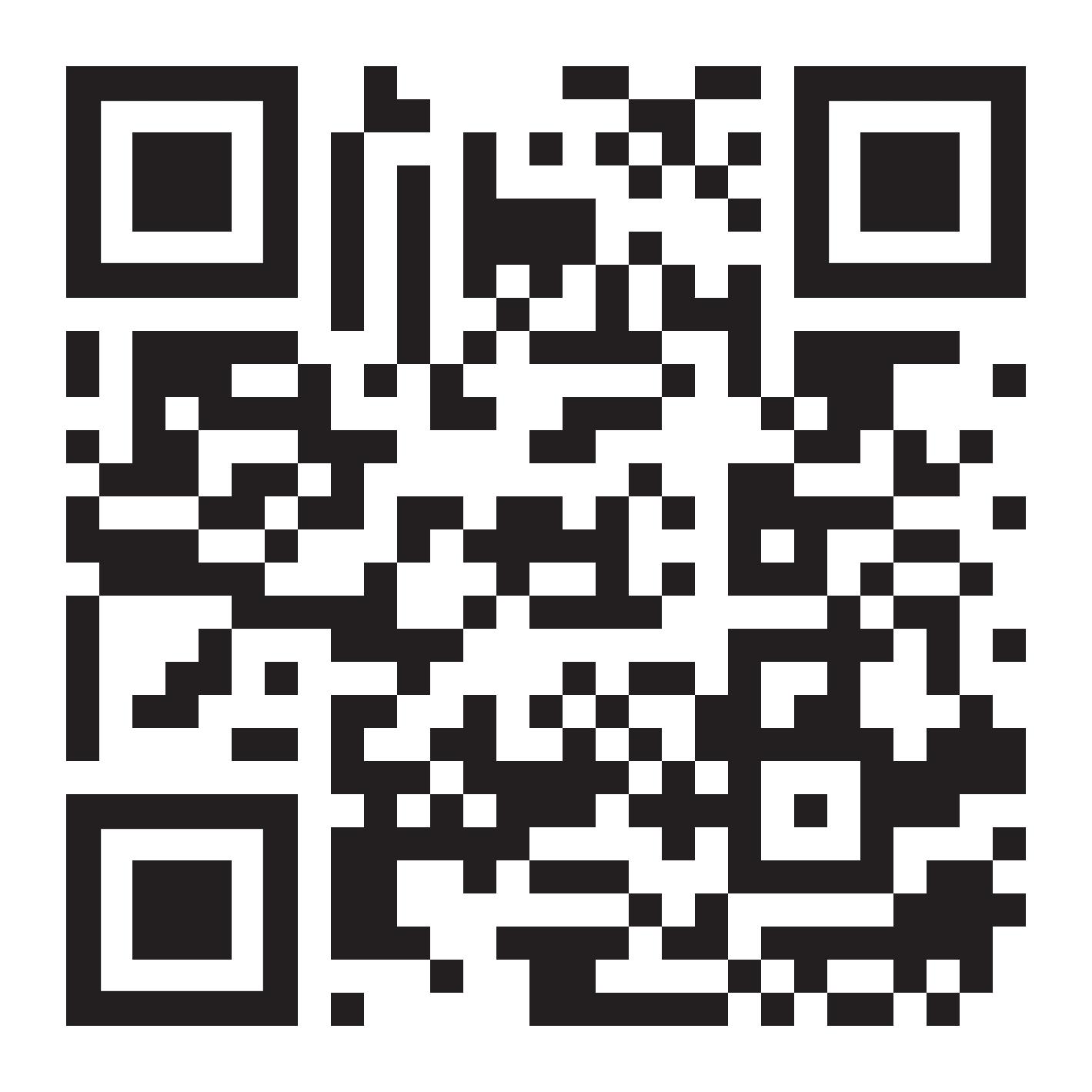
Photographer Justin Cox photographer@thenorthernlight.org
Media Adviser Paola Banchero
Administrative Adviser Zac Clark
Fiscal Technician Micah Perino
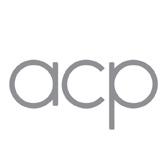
The Northern Light is a proud member of the Associated Collegiate Press. The Northern Light is a weekly UAA publication funded by student fees and advertising sales. The editors and writers of The Northern Light are solely responsible for its contents. Circulation is 2,500. The University of Alaska Anchorage provides equal education and employment opportunities for all, regardless of race, color, religion, national origin, age, sex, Vietnam-era or disabled-veteran status, physical or mental disability, changes in marital status, pregnancy or parenthood. The views expressed in the opinion section do not necessarily reflect the views of UAA or the Northern Light.
The University of Alaska is an affirmative action/equal opportunity employer and educational institution. The University of Alaska does not discriminate on the basis of race, religion, color, national origin, citizenship, age, sex, physical or mental disability, status as a protected veteran, marital status, changes in marital status, pregnancy, childbirth or related medical conditions, parenthood, sexual orientation, gender identity, political affiliation or belief, genetic information, or other legally protected status. The University’s commitment to nondiscrimination, including against sex discrimination, applies to students, employees, and applicants for admission and employment. Contact information, applicable laws, and complaint procedures are included on UA’s statement of nondiscrimination available at www.alaska. edu/nondiscrimination.
The Northern Light encourages readers to express their views in the newspaper. The Northern Light reserves the right to reject or publish any submission, online or in print.
Letters to the editor can be submitted to editor@thenorthernlight.org. The maximum length for a letter to the editor is 250 words, and 150 words for letters specifically endorsing candidates for federal, local, or university office. A letter to the editor is written by someone who does not have authoritative knowledge on the subject they are discussing. Contributors are restricted to one published letter to the editor per month.
Opinion pieces can be submitted to editor@thenorthernlight.org. The maximum length for a contributor’s opinion piece is 450 words. Contributors are restricted to one published opinion piece per month. Opinion pieces written by staff of The Northern Light are limited to 800 words. An opinion piece that is published in The Northern Light should be written by someone who has authoritative knowledge on the subject they are discussing.
Letters and opinion pieces are subject to editing for grammar, accuracy, length and clarity. All letters and opinion pieces must include names, major and/or group affiliation and contact information for verification purposes. The Northern Light will not publish anonymous letters or pseudonyms. Requests for corrections can be sent to editor@thenorthernlight.org. Print publication is subject to accuracy and available space. All corrections are posted online with the original story at www. thenorthernlight.org. The deadline for submissions is the Friday before publication at noon, no exceptions.
The Northern Light newsroom is located on the first floor of the Student Union Room 118.
The Northern Light is hiring! See our job listings at careers.alaska.edu.
